Marc Tyler Nobleman's Blog, page 143
October 4, 2011
Super '70s and '80s: "Scooby-Doo, Where Are You!"—introduction
Introduction to series "Super '70s and '80s."
Scooby-Doo and his gang do good deeds like superheroes and have even worked with superheroes (Batman and Robin)...
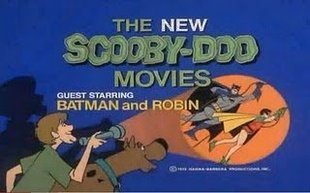 ...but they're not superheroes themselves.
...but they're not superheroes themselves.
Nonetheless, Scooby-Doo is included in this predominantly superhero-focused series (as the last addition), and the reason is that he, tied with Super Friends, was my childhood favorite. Also, the Scooby people I was most interested in fit the criteria of most of the others in this series: they have not been interviewed before about their Scooby role.
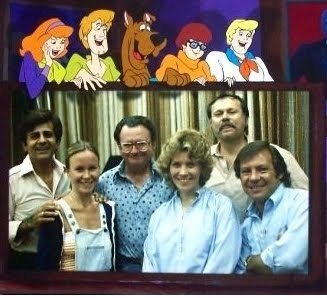 The voice cast (mid-1970s), most of whom have been interviewed before:
The voice cast (mid-1970s), most of whom have been interviewed before:
Casey Kasem (Shaggy), Heather North (Daphne),
Don Messick (Scooby-Doo), Pat Stevens (Velma),
Don Jurwich (producer), Frank Welker (Fred).
Photo courtesy of Frank Welker.
I got permission to post all images; if you want to repost, please do the same and ask me first.
Welcome to the first-ever oral history of Scooby-Doo, Where Are You! [NOTE: My focus was on the first two seasons.]
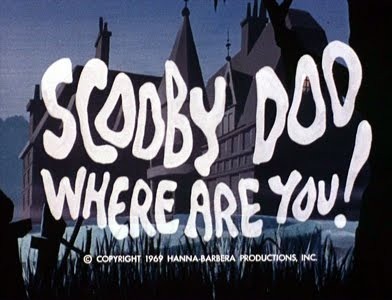 Theme song singers interviewed (2 parts):
Theme song singers interviewed (2 parts):
Larry Marks, theme song singer, season 1
Austin Roberts, theme song and "chase songs" singer, season 2
Theme song production staff interviewed (2 parts):
Danny Janssen, producer
Rose Marie Mook and Nick Mook, widow and son of theme co-writer David Mook
Voice actors interviewed (2 parts):
Nicole David (Jaffe) (Velma 1, 1969-74)
Heather Kenney (North) (Daphne 2, beginning in season 2, 1970)
Scooby-Doo and his gang do good deeds like superheroes and have even worked with superheroes (Batman and Robin)...
 ...but they're not superheroes themselves.
...but they're not superheroes themselves.Nonetheless, Scooby-Doo is included in this predominantly superhero-focused series (as the last addition), and the reason is that he, tied with Super Friends, was my childhood favorite. Also, the Scooby people I was most interested in fit the criteria of most of the others in this series: they have not been interviewed before about their Scooby role.
 The voice cast (mid-1970s), most of whom have been interviewed before:
The voice cast (mid-1970s), most of whom have been interviewed before:Casey Kasem (Shaggy), Heather North (Daphne),
Don Messick (Scooby-Doo), Pat Stevens (Velma),
Don Jurwich (producer), Frank Welker (Fred).
Photo courtesy of Frank Welker.
I got permission to post all images; if you want to repost, please do the same and ask me first.
Welcome to the first-ever oral history of Scooby-Doo, Where Are You! [NOTE: My focus was on the first two seasons.]
 Theme song singers interviewed (2 parts):
Theme song singers interviewed (2 parts):Larry Marks, theme song singer, season 1
Austin Roberts, theme song and "chase songs" singer, season 2
Theme song production staff interviewed (2 parts):
Danny Janssen, producer
Rose Marie Mook and Nick Mook, widow and son of theme co-writer David Mook
Voice actors interviewed (2 parts):
Nicole David (Jaffe) (Velma 1, 1969-74)
Heather Kenney (North) (Daphne 2, beginning in season 2, 1970)
Published on October 04, 2011 04:32
October 3, 2011
Super '70s and '80s: "Superman" (1988 Ruby-Spears cartoon)—Beau Weaver (Superman), part 2 of 2
Introduction to series "Super '70s and '80s."
Part 1 of 2.
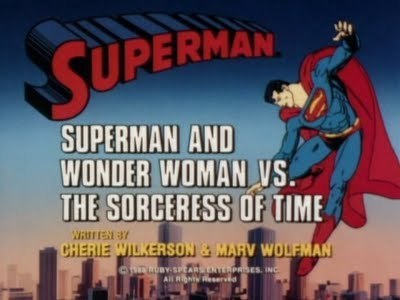 Now, in conclusion: one more story with two lessons.
Now, in conclusion: one more story with two lessons.
When I finally produced an animation demo that my agent liked, I waited. And waited. Nothing. I sent out demos, promotional postcards, and muffin baskets to animation casting directors. No bites.
I got a call from my grey-haired mother back in Austin, Texas. I shared my frustrations. She said, "Why, honey, you should write to those fellows at Hanna-Barbera and remind them about that letter you wrote them when you were eight."
See, my grandmother got me started writing letters to famous people as soon as I could write on my own. I wrote to astronauts, senators, actor Ed "Kookie" Burns of 77 Sunset Strip…and I got letters back from most of them. In 1960, when The Flintstones premiered in primetime on ABC, I became enamored of it and learned to draw a decent Fred Flintstone. So I wrote to Mr. Bill Hanna and Mr. Joe Barbera, the show's creators.
The letter went something like this: "Hello, I am a third grader in Oklahoma, and as you can see, I can draw Fred Flintstone. Can you use me?"
Amazingly, I got a kind reply, probably written by some secretary over their signatures. It explained that, no, they could not use an eight-year-old in Oklahoma to help animate the show, but that I showed talent and initiative, and if, when I grew up, I became a professional illustrator and happened to live in Southern California, by all means contact them. And there was a line about believing in yourself and going for your dreams. Very nice.
So Mom continues: "Why don't you just call them up and remind them about that letter." Mom. Mom. Sigh. No, you don't understand. This is big-time Hollywood out here. We are represented by talent agents; we don't go calling up producers about letters they received from children decades ago. That's just ridiculous. Forget it.
However, after a few more months of no response, I thought, "Oh, what the hell." So I wrote: "Dear Mr. Hanna and Mr. Barbera: You could not possibly remember this, but as a child I wrote to you with my scrawled drawing of Fred Flintstone, offering to go to work for you from my home in Oklahoma. Kindly, you wrote back and suggested that if I became a commercial artist when I grew up, I should look you up. Well, as it happens, I am a professional voice-over talent living in Los Angeles and I thought I would see if that offer still stands. I have not been able to make any inroads with your casting people and my mother thought I should ask you if you would be willing to let me audition for any roles you have coming up. Sorry to have bothered you… Sincerely, etc. I mailed the letter and promptly forgot about it.
About three weeks later, I got a call from one of the partners of the talent agency that represented me. This was the top guy, not an in-the trenches agent. "Beau…," he began, tentatively, "…I have a booking here for you for next week…for a general audition at Hanna Barbera." I was over the moon! "That's fantastic" I shouted. "Well, yes, I suppose it is," he continued, "but I am a little unclear as to how this came to be. Hanna-Barbera has not done general auditions for actors in a very long time. And if they started doing them again, we might typically be given four or five slots, and frankly, Beau, you would not be one of the first actors that would come to mind. Or the fifteenth. Be that as it may, they only seem to want to see one actor…um, you." "Well," I said, "I guess they just appreciate talent over there at Hanna-Barbera!'
Over the next few days I practiced the audition material I had assembled in Sue Blu's animation workshop and excitedly made my way to the famous HB studios on Cahuenga in Universal City. I was greeted by animation director Gordon Hunt, who graciously put me at ease right away. In retrospect, I am quite certain that my little audition was mediocre at best. But, amazingly, a few days later, my agent called me with a real live SAG booking from Hanna-Barbera! It was for a small part on the series Flintstone Kids—a show about Fred and Wilma and the gang as children. My role, barely more than an incidental, was kid Betty's older brother, Brick Bricker.
Soon thereafter, my animation career started to take off with roles on Transformers, The Visionaries, a Jetsons TV-movie, and finally, my dream come true: Superman.
The two lessons from this story:
1) Use whatever you have.
2) Listen to your mother.
Today, most of my work is in television promos, trailers and television campaigns for feature films, and narrating documentary series for cable networks. I am the announcer on CBS's entertainment news show The Insider and the syndicated CBS daily medical talk show The Doctors. I am the narrator on National Geographic's Known Universe, Animal Planet's Weird, True & Freaky and Discovery Channel's American Loggers. I am frequently heard on radio and television commercials.
I am booked back-to-back from my home studios in the Ojai Valley and in Los Angeles and am not able to do the all-day recording sessions that animation often requires. I was one of the early technical pioneers of the system which makes voice over work possible from remote locations. This is a good example of what can happen when you are willing to become an empty vessel and to open yourself to something outside of what you already know.
Other roles? My next favorite roll was as Reed Richards (Mister Fantastic) in the 1995 Fantastic Four. Stan Lee himself came to many of the sessions, and as is his Hitchcockian custom, made cameo voice appearances in several episodes.
I was also fortunate to work on Mighty Mouse: The New Adventures, created for CBS by visionary madman Ralph Bakshi. What an experience. Ralph would scream at the actors and sometimes throw away the script and have us ad-lib an ending. John Kricfalusi, creator of Ren and Stimpy, was part of the animation team. Bakshi was a real trip! CBS had no idea what they had signed up for.
I am married and have three grown daughters from a previous marriage; they have given me eight grandchildren so far.
The daughters and grandchildren are nonplussed by hearing me on television and in movie theaters. It seems normal to them.
This is much more than you asked for, I know. A couple of other questions, I may have missed. No, I have never been to a convention, but would enjoy going if invited.
One last story: My oldest daughter Susannah was being picked up by her carpool on the way to kindergarten. Her schoolmate Jeff's mom was driving. As she hopped into the front seat, she [heard a radio] commercial. "So is that your dad?" she asked Jeff. "No…?" he asked in a puzzled tone, "why?" Susannah said, "Well…it's your car."
My daughter thought everyone's daddy's voice came out of the dashboards of their cars. That was normal for her.
It has not been easy being my child. But I set aside money early on to pay for the therapy. So it's okay.
Next: Scooby-Doo, Where Are You!
Part 1 of 2.
 Now, in conclusion: one more story with two lessons.
Now, in conclusion: one more story with two lessons.When I finally produced an animation demo that my agent liked, I waited. And waited. Nothing. I sent out demos, promotional postcards, and muffin baskets to animation casting directors. No bites.
I got a call from my grey-haired mother back in Austin, Texas. I shared my frustrations. She said, "Why, honey, you should write to those fellows at Hanna-Barbera and remind them about that letter you wrote them when you were eight."
See, my grandmother got me started writing letters to famous people as soon as I could write on my own. I wrote to astronauts, senators, actor Ed "Kookie" Burns of 77 Sunset Strip…and I got letters back from most of them. In 1960, when The Flintstones premiered in primetime on ABC, I became enamored of it and learned to draw a decent Fred Flintstone. So I wrote to Mr. Bill Hanna and Mr. Joe Barbera, the show's creators.
The letter went something like this: "Hello, I am a third grader in Oklahoma, and as you can see, I can draw Fred Flintstone. Can you use me?"
Amazingly, I got a kind reply, probably written by some secretary over their signatures. It explained that, no, they could not use an eight-year-old in Oklahoma to help animate the show, but that I showed talent and initiative, and if, when I grew up, I became a professional illustrator and happened to live in Southern California, by all means contact them. And there was a line about believing in yourself and going for your dreams. Very nice.
So Mom continues: "Why don't you just call them up and remind them about that letter." Mom. Mom. Sigh. No, you don't understand. This is big-time Hollywood out here. We are represented by talent agents; we don't go calling up producers about letters they received from children decades ago. That's just ridiculous. Forget it.
However, after a few more months of no response, I thought, "Oh, what the hell." So I wrote: "Dear Mr. Hanna and Mr. Barbera: You could not possibly remember this, but as a child I wrote to you with my scrawled drawing of Fred Flintstone, offering to go to work for you from my home in Oklahoma. Kindly, you wrote back and suggested that if I became a commercial artist when I grew up, I should look you up. Well, as it happens, I am a professional voice-over talent living in Los Angeles and I thought I would see if that offer still stands. I have not been able to make any inroads with your casting people and my mother thought I should ask you if you would be willing to let me audition for any roles you have coming up. Sorry to have bothered you… Sincerely, etc. I mailed the letter and promptly forgot about it.
About three weeks later, I got a call from one of the partners of the talent agency that represented me. This was the top guy, not an in-the trenches agent. "Beau…," he began, tentatively, "…I have a booking here for you for next week…for a general audition at Hanna Barbera." I was over the moon! "That's fantastic" I shouted. "Well, yes, I suppose it is," he continued, "but I am a little unclear as to how this came to be. Hanna-Barbera has not done general auditions for actors in a very long time. And if they started doing them again, we might typically be given four or five slots, and frankly, Beau, you would not be one of the first actors that would come to mind. Or the fifteenth. Be that as it may, they only seem to want to see one actor…um, you." "Well," I said, "I guess they just appreciate talent over there at Hanna-Barbera!'
Over the next few days I practiced the audition material I had assembled in Sue Blu's animation workshop and excitedly made my way to the famous HB studios on Cahuenga in Universal City. I was greeted by animation director Gordon Hunt, who graciously put me at ease right away. In retrospect, I am quite certain that my little audition was mediocre at best. But, amazingly, a few days later, my agent called me with a real live SAG booking from Hanna-Barbera! It was for a small part on the series Flintstone Kids—a show about Fred and Wilma and the gang as children. My role, barely more than an incidental, was kid Betty's older brother, Brick Bricker.
Soon thereafter, my animation career started to take off with roles on Transformers, The Visionaries, a Jetsons TV-movie, and finally, my dream come true: Superman.
The two lessons from this story:
1) Use whatever you have.
2) Listen to your mother.
Today, most of my work is in television promos, trailers and television campaigns for feature films, and narrating documentary series for cable networks. I am the announcer on CBS's entertainment news show The Insider and the syndicated CBS daily medical talk show The Doctors. I am the narrator on National Geographic's Known Universe, Animal Planet's Weird, True & Freaky and Discovery Channel's American Loggers. I am frequently heard on radio and television commercials.
I am booked back-to-back from my home studios in the Ojai Valley and in Los Angeles and am not able to do the all-day recording sessions that animation often requires. I was one of the early technical pioneers of the system which makes voice over work possible from remote locations. This is a good example of what can happen when you are willing to become an empty vessel and to open yourself to something outside of what you already know.
Other roles? My next favorite roll was as Reed Richards (Mister Fantastic) in the 1995 Fantastic Four. Stan Lee himself came to many of the sessions, and as is his Hitchcockian custom, made cameo voice appearances in several episodes.
I was also fortunate to work on Mighty Mouse: The New Adventures, created for CBS by visionary madman Ralph Bakshi. What an experience. Ralph would scream at the actors and sometimes throw away the script and have us ad-lib an ending. John Kricfalusi, creator of Ren and Stimpy, was part of the animation team. Bakshi was a real trip! CBS had no idea what they had signed up for.
I am married and have three grown daughters from a previous marriage; they have given me eight grandchildren so far.
The daughters and grandchildren are nonplussed by hearing me on television and in movie theaters. It seems normal to them.
This is much more than you asked for, I know. A couple of other questions, I may have missed. No, I have never been to a convention, but would enjoy going if invited.
One last story: My oldest daughter Susannah was being picked up by her carpool on the way to kindergarten. Her schoolmate Jeff's mom was driving. As she hopped into the front seat, she [heard a radio] commercial. "So is that your dad?" she asked Jeff. "No…?" he asked in a puzzled tone, "why?" Susannah said, "Well…it's your car."
My daughter thought everyone's daddy's voice came out of the dashboards of their cars. That was normal for her.
It has not been easy being my child. But I set aside money early on to pay for the therapy. So it's okay.
Next: Scooby-Doo, Where Are You!
Published on October 03, 2011 04:15
October 2, 2011
Super '70s and '80s: "Superman" (1988 Ruby-Spears cartoon)—Beau Weaver (Superman), part 1 of 2
Introduction to series "Super '70s and '80s."
Now for something different. The only person I interviewed in connection to this show was its star, the genial Beau Weaver, the voice of Superman.
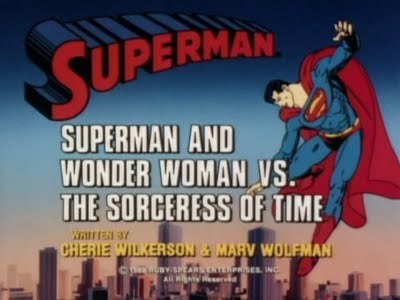 He responded to my questionnaire with a spirited narrative, so I will just run it as is rather than force it back into a Q&A format.
He responded to my questionnaire with a spirited narrative, so I will just run it as is rather than force it back into a Q&A format.
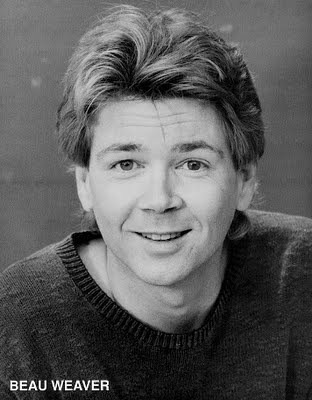 Then
Then
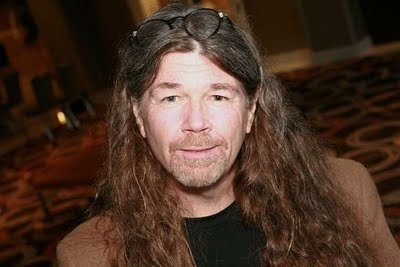 Now
Now
I got permission to post all images; if you want to repost, please do the same and ask me first.
Beau Weaver—in his own (well-stated) words:
Like most jobs for voice actors, Superman began as an audition through my agent. The casting process on this was a little bit unusual. Ruby-Spears first selected several potential candidates for the job of director. Each of the candidates was to run their own casting sessions, bringing in the actors they wanted to audition for the role.
Among the potential directors were Ginnny McSwain and Michael Bell [who is interviewed in the Super Friends section of this series]. I was brought in to read for Superman by Mike Bell. My background is radio. And I think Mike may have had in mind the actor who [once did radio and who then] played Superman in Super Friends, Danny Dark. Danny and I are both from Oklahoma and, in fact, I used to call him up and request records when I was a kid! Danny had the resonant, authoritative sound that is characteristic of the classic announcer.
But as I looked over the sides, Mike asked me to play against that, taking cues from the more gentle characterization of Christopher Reeve. I think several other animation actors with a similar background also read for Mike—Neal Ross and Brian Cummings among them, surely. It was a huge honor to be asked to audition, and great fun, but as with most roles I read for, I immediately put it out of my mind. If you invest too much hope in anything you audition for in Hollywood, you will make yourself completely crazy, as even the most talented performers book only a tiny fraction of the projects they are up for.
As it turned out, Ruby-Spears selected Ginny McSwain as director. As you may recall, she also played the part of Lois Lane [in that show]. But she did not cast herself. Actually, Ginny had also been brought in to read by Michael Bell—a surprising but inspired bit of casting genius. Anyone who knows Ginny will tell you: she IS Lois Lane. So, Ginny won both the role of director and, thanks to Michael Bell, the role of Lois. And, as turnabout is fair play, Michael Bell won the roll of Lex Luthor, playing completely against type, making him a villain with subtle, quiet menace, more along the lines of an Anthony Hopkins than the scenery-chewing types that one might expect. Michael had been brought in to read for the role by…Ginny McSwain!
My agent at the time, Arlene Thornton, called me with the astonishing news that I had won the role of Superman. I really thought she was joking. This was a real dream come true for me. I was a huge comic book fan growing up in Oklahoma. My grandfather ran a drug store in a small town; he kept three racks full of comic books in stock, and I devoured every one of them. I read everything, but my absolute favorite was DC Comics superheroes. And, for me, it was always about Superman. As a child of five, I could recite the "Faster than a speeding bullet…" intro to the television series. For Christmas one year, I got my most-wished-for gift ever, a Superman suit. And I must tell you that I was crushed when I read, printed on the shirt tale of the costume, "Remember: this suit will not make you fly; only Superman can fly." It's a lucky thing they put that disclaimer there or I would have climbed up to the roof and jumped off. Seriously.
The first recording sessions were a blur. I thought I was dreaming. I was just sure that someone was going to come in and tell me that it was all a big mistake and that I was not really playing Superman.
The scripts were great. DC Comics writer Marv Wolfman was story editor. He came to a few of the recording sessions. The show concluded with a short segment that I thought was particularly good, "The Superman Family Album"; [it focused on] the backstory—Superboy in Smallville with Ma and Pa Kent.
The show was [produced] to coincide with the fiftieth anniversary of the [debut] of Superman. But to my way of thinking, CBS made two critical mistakes when it aired. First, contrary to what we were told, there was very little advance promotion for the show. And it was scheduled very early in the Saturday morning lineup, in a time slot usually reserved for shows aimed at very young children, like Muppet Babies. This sort of show would more reasonably be programmed at 9 or 10 a.m. And shows later in the lineup benefit from interstitial promos that earlier shows do not receive. And the naming of the show was unfortunate. It was called simply Superman. Better branding might have resulted from naming it Superman: The New Adventures or The All-New Superman. A listing in TV Guide or the newspaper TV listings that read simply "Superman" did not spotlight it as a new series, did not distinguish it [enough] from reruns of the old George Reeves show or even from Super Friends. So with no marketing, poor branding, and a crappy time slot, it failed to perform in the ratings and was not renewed for another season.
Toward the end of the thirteen-episode order, Ruby-Spears productions was acquired by Hanna-Barbera. The final episodes were recorded at the HB studios in Universal City. There was a tiny cast party with cake and champagne when we finished the final episode, but it was a muted celebration since we were not to be renewed.
A few years ago, a fan sent me a link to a website selling the Ruby-Spears Superman series on DVD. I bought it, but was disappointed to discover that it was simply a digitized version of some very poor off the air recordings made on VHS tapes. They were almost unwatchable. But it was still fun to see how well they held up. Standout performances were from Michael Bell as Luthor and Mark L. Taylor [also interviewed in the Super Friends subseries] as Jimmy Olsen. I did notice that in the earlier episodes, I was directed to underplay the macho of Superman. However, as we got further into the season, Ginny had me "butch it up" just a bit. I only wish we had been more consistent throughout all thirteen episodes.
You might be interested in how I got into animation. This story is included in James Alburger's third edition of The Art of Voice Acting, published [in 2010].
Radio was my first love. I started hanging around radio stations when I was about eleven. By fifteen, I weaseled my way into my first on-air job in Houston. Whether because of talent or obsessive hard work or both, by the mid seventies I had climbed the ladder to land at my dream station, the number one pop music station in the country, the legendary Boss Radio 93/KHJ in Los Angeles. One night, I found one of the other air personalities in a production studio where he was not allowed to touch the equipment, making copies of what sounded like a string of snippets of him doing commercials. "What's that?" I asked. "My voice-over demo," he said. And my whole world changed.
But he cautioned me that Hollywood takes a dim view of radio deejays in the world of voice acting. They think we have a sort of "radio accent," he explained. But, luckily, there is a kind of therapy for that…and he invited me to a voice-over workshop held weekly in the home of the queen of Hollywood voice-over, Joan Gerber. On some nights, it was co-directed by none other than Michael Bell. For some reason, I was not stopped by my big-time radio-guy ego and was willing to become a beginner; and [so] began a journey that eventually had me leaving radio behind for a much more challenging and lucrative career as a full-time freelance voice-over actor.
Cut to the mid-eighties. In the lobby of my agent's office in Beverly Hills, two other voice actors were rehearsing sides for an animated cartoon series. They were Bob Arbogast and, [again], the great Michael Bell, one of the finest and most versatile voice actors who ever worked. As I listened to them, I remarked that I had always thought animation must be a lot of fun and that maybe I would give it a try someday. Well, Michael smiled smugly and told me in no uncertain terms that I had "no shot" at animation because "you come from a broadcast background and animation…well, this is for real actors."
Ouch. Truth be told, I was not really all that interested in animation. But now that Mike Bell says I can't do it? Okay; it's on. Now I had a mission.
Even in the eighties, I had a serviceable home studio, and over the next few weeks I spent many, many hours working on putting together an animation demo reel. When I thought I was ready, I took it to Arlene [my agent at the time]. She called me in for a meeting to discuss the reel and she asked her husband Jack Angel (a former radio personality who had become a major voice actor in animation) to sit in on the meeting.
They were kind, but blunt. My reel, they said, showed talent, but it was really not much more than just a bunch of funny voices. They explained that animation voice work is acting, not funny voices. Jack then pointed out that several of the characters I had on my reel were directly derivative of characters created by animation masters Daws Butler and Don Messick. Jack said, "I don't think you are intentionally stealing their work, but I figure that you have just grown up hearing them in cartoons, and so that's what you think cartoons sound like. These are not bad impressions, but, out here, if they want Don Messick, they will just get the real guy. You have to do something original."
They had several suggestions. Arlene said she knew how committed I [could] be when I [got] my mind set on something, but warned that this one might be hard for me to swallow. "There is an animation workshop you really ought to take," she said. "It's taught by…Michael Bell." Ouch again. She also recommended a class taught by Susan Blu. But Jack Angel had the hardest suggestion for me to take: "What you really need is to take an acting class."
After swallowing more pride, I found the willingness to become a beginner…again. [And] this time, after years as a successful voice actor working in Hollywood. Both the Michael Bell and Susan Blu workshops were invaluable introductions to creating characters and the very specific technical skills that are peculiar to animation work. But the most difficult for me was the acting classes.
With a "face for radio," I had no idea how to do what I do when my body was involved. It was like trying to breathe water. Over the next two years, I took beginning acting classes and scene study workshops. I felt like the football player who had been instructed to enroll in ballet class to improve his agility. I understood the concept, but felt like a hippopotamus among the ballerinas. I never felt as lost as I did those first few months. But gradually, something began to open up in my work. I learned to breathe differently. I came to fully understand and own that, yes, I am an actor. I can do this! But it took time. And it took showing up, even when I could not see the point.
Part 2.
Now for something different. The only person I interviewed in connection to this show was its star, the genial Beau Weaver, the voice of Superman.
 He responded to my questionnaire with a spirited narrative, so I will just run it as is rather than force it back into a Q&A format.
He responded to my questionnaire with a spirited narrative, so I will just run it as is rather than force it back into a Q&A format. Then
Then Now
NowI got permission to post all images; if you want to repost, please do the same and ask me first.
Beau Weaver—in his own (well-stated) words:
Like most jobs for voice actors, Superman began as an audition through my agent. The casting process on this was a little bit unusual. Ruby-Spears first selected several potential candidates for the job of director. Each of the candidates was to run their own casting sessions, bringing in the actors they wanted to audition for the role.
Among the potential directors were Ginnny McSwain and Michael Bell [who is interviewed in the Super Friends section of this series]. I was brought in to read for Superman by Mike Bell. My background is radio. And I think Mike may have had in mind the actor who [once did radio and who then] played Superman in Super Friends, Danny Dark. Danny and I are both from Oklahoma and, in fact, I used to call him up and request records when I was a kid! Danny had the resonant, authoritative sound that is characteristic of the classic announcer.
But as I looked over the sides, Mike asked me to play against that, taking cues from the more gentle characterization of Christopher Reeve. I think several other animation actors with a similar background also read for Mike—Neal Ross and Brian Cummings among them, surely. It was a huge honor to be asked to audition, and great fun, but as with most roles I read for, I immediately put it out of my mind. If you invest too much hope in anything you audition for in Hollywood, you will make yourself completely crazy, as even the most talented performers book only a tiny fraction of the projects they are up for.
As it turned out, Ruby-Spears selected Ginny McSwain as director. As you may recall, she also played the part of Lois Lane [in that show]. But she did not cast herself. Actually, Ginny had also been brought in to read by Michael Bell—a surprising but inspired bit of casting genius. Anyone who knows Ginny will tell you: she IS Lois Lane. So, Ginny won both the role of director and, thanks to Michael Bell, the role of Lois. And, as turnabout is fair play, Michael Bell won the roll of Lex Luthor, playing completely against type, making him a villain with subtle, quiet menace, more along the lines of an Anthony Hopkins than the scenery-chewing types that one might expect. Michael had been brought in to read for the role by…Ginny McSwain!
My agent at the time, Arlene Thornton, called me with the astonishing news that I had won the role of Superman. I really thought she was joking. This was a real dream come true for me. I was a huge comic book fan growing up in Oklahoma. My grandfather ran a drug store in a small town; he kept three racks full of comic books in stock, and I devoured every one of them. I read everything, but my absolute favorite was DC Comics superheroes. And, for me, it was always about Superman. As a child of five, I could recite the "Faster than a speeding bullet…" intro to the television series. For Christmas one year, I got my most-wished-for gift ever, a Superman suit. And I must tell you that I was crushed when I read, printed on the shirt tale of the costume, "Remember: this suit will not make you fly; only Superman can fly." It's a lucky thing they put that disclaimer there or I would have climbed up to the roof and jumped off. Seriously.
The first recording sessions were a blur. I thought I was dreaming. I was just sure that someone was going to come in and tell me that it was all a big mistake and that I was not really playing Superman.
The scripts were great. DC Comics writer Marv Wolfman was story editor. He came to a few of the recording sessions. The show concluded with a short segment that I thought was particularly good, "The Superman Family Album"; [it focused on] the backstory—Superboy in Smallville with Ma and Pa Kent.
The show was [produced] to coincide with the fiftieth anniversary of the [debut] of Superman. But to my way of thinking, CBS made two critical mistakes when it aired. First, contrary to what we were told, there was very little advance promotion for the show. And it was scheduled very early in the Saturday morning lineup, in a time slot usually reserved for shows aimed at very young children, like Muppet Babies. This sort of show would more reasonably be programmed at 9 or 10 a.m. And shows later in the lineup benefit from interstitial promos that earlier shows do not receive. And the naming of the show was unfortunate. It was called simply Superman. Better branding might have resulted from naming it Superman: The New Adventures or The All-New Superman. A listing in TV Guide or the newspaper TV listings that read simply "Superman" did not spotlight it as a new series, did not distinguish it [enough] from reruns of the old George Reeves show or even from Super Friends. So with no marketing, poor branding, and a crappy time slot, it failed to perform in the ratings and was not renewed for another season.
Toward the end of the thirteen-episode order, Ruby-Spears productions was acquired by Hanna-Barbera. The final episodes were recorded at the HB studios in Universal City. There was a tiny cast party with cake and champagne when we finished the final episode, but it was a muted celebration since we were not to be renewed.
A few years ago, a fan sent me a link to a website selling the Ruby-Spears Superman series on DVD. I bought it, but was disappointed to discover that it was simply a digitized version of some very poor off the air recordings made on VHS tapes. They were almost unwatchable. But it was still fun to see how well they held up. Standout performances were from Michael Bell as Luthor and Mark L. Taylor [also interviewed in the Super Friends subseries] as Jimmy Olsen. I did notice that in the earlier episodes, I was directed to underplay the macho of Superman. However, as we got further into the season, Ginny had me "butch it up" just a bit. I only wish we had been more consistent throughout all thirteen episodes.
You might be interested in how I got into animation. This story is included in James Alburger's third edition of The Art of Voice Acting, published [in 2010].
Radio was my first love. I started hanging around radio stations when I was about eleven. By fifteen, I weaseled my way into my first on-air job in Houston. Whether because of talent or obsessive hard work or both, by the mid seventies I had climbed the ladder to land at my dream station, the number one pop music station in the country, the legendary Boss Radio 93/KHJ in Los Angeles. One night, I found one of the other air personalities in a production studio where he was not allowed to touch the equipment, making copies of what sounded like a string of snippets of him doing commercials. "What's that?" I asked. "My voice-over demo," he said. And my whole world changed.
But he cautioned me that Hollywood takes a dim view of radio deejays in the world of voice acting. They think we have a sort of "radio accent," he explained. But, luckily, there is a kind of therapy for that…and he invited me to a voice-over workshop held weekly in the home of the queen of Hollywood voice-over, Joan Gerber. On some nights, it was co-directed by none other than Michael Bell. For some reason, I was not stopped by my big-time radio-guy ego and was willing to become a beginner; and [so] began a journey that eventually had me leaving radio behind for a much more challenging and lucrative career as a full-time freelance voice-over actor.
Cut to the mid-eighties. In the lobby of my agent's office in Beverly Hills, two other voice actors were rehearsing sides for an animated cartoon series. They were Bob Arbogast and, [again], the great Michael Bell, one of the finest and most versatile voice actors who ever worked. As I listened to them, I remarked that I had always thought animation must be a lot of fun and that maybe I would give it a try someday. Well, Michael smiled smugly and told me in no uncertain terms that I had "no shot" at animation because "you come from a broadcast background and animation…well, this is for real actors."
Ouch. Truth be told, I was not really all that interested in animation. But now that Mike Bell says I can't do it? Okay; it's on. Now I had a mission.
Even in the eighties, I had a serviceable home studio, and over the next few weeks I spent many, many hours working on putting together an animation demo reel. When I thought I was ready, I took it to Arlene [my agent at the time]. She called me in for a meeting to discuss the reel and she asked her husband Jack Angel (a former radio personality who had become a major voice actor in animation) to sit in on the meeting.
They were kind, but blunt. My reel, they said, showed talent, but it was really not much more than just a bunch of funny voices. They explained that animation voice work is acting, not funny voices. Jack then pointed out that several of the characters I had on my reel were directly derivative of characters created by animation masters Daws Butler and Don Messick. Jack said, "I don't think you are intentionally stealing their work, but I figure that you have just grown up hearing them in cartoons, and so that's what you think cartoons sound like. These are not bad impressions, but, out here, if they want Don Messick, they will just get the real guy. You have to do something original."
They had several suggestions. Arlene said she knew how committed I [could] be when I [got] my mind set on something, but warned that this one might be hard for me to swallow. "There is an animation workshop you really ought to take," she said. "It's taught by…Michael Bell." Ouch again. She also recommended a class taught by Susan Blu. But Jack Angel had the hardest suggestion for me to take: "What you really need is to take an acting class."
After swallowing more pride, I found the willingness to become a beginner…again. [And] this time, after years as a successful voice actor working in Hollywood. Both the Michael Bell and Susan Blu workshops were invaluable introductions to creating characters and the very specific technical skills that are peculiar to animation work. But the most difficult for me was the acting classes.
With a "face for radio," I had no idea how to do what I do when my body was involved. It was like trying to breathe water. Over the next two years, I took beginning acting classes and scene study workshops. I felt like the football player who had been instructed to enroll in ballet class to improve his agility. I understood the concept, but felt like a hippopotamus among the ballerinas. I never felt as lost as I did those first few months. But gradually, something began to open up in my work. I learned to breathe differently. I came to fully understand and own that, yes, I am an actor. I can do this! But it took time. And it took showing up, even when I could not see the point.
Part 2.
Published on October 02, 2011 04:02
October 1, 2011
Super '70s and '80s: "The Plastic Man Comedy Adventure Show"—Mark Taylor (Plastic Man—live action)
Introduction to series "Super '70s and '80s."
Introduction to subseries "The Plastic Man Comedy Adventure Show" (including list of interviewees).
Getting to know Mark Taylor was one of the most moving aspects of this experience for me. I will not elaborate because you will soon see why, but I will say that during our actual conversation, there was a lot of "Wow," "My gosh," "You are an inspiration," and the like from me. In transcribing, I have cut that out so you can mentally insert your own reactions as you read.
NOTE: Some of Mark's turns-of-a-phrase in e-mail showed that he was able to snap right back into Plastic Man mode. My favorite was a time when he had to reschedule a talk:
"You have to be flexible if you're going to deal with Plastic Man."
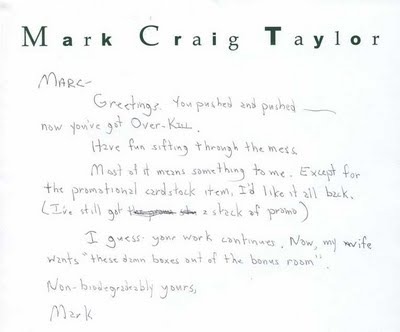 How did you get the job on Plastic Man?
How did you get the job on Plastic Man?
It's coincidental. I was doing comedy in San Francisco and doing a little acting, modeling, commercial work.
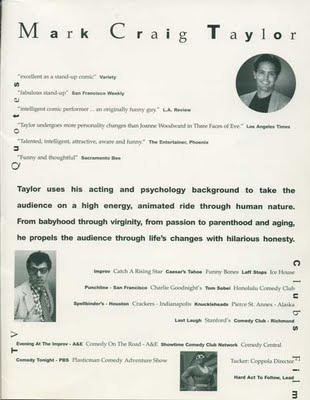 One of my agents [told me that there was] an audition for this cartoon character. My interest was not at all in doing in a children's show. This was about an hour out of San Francisco. I declined to do it. Most auditions aren't fruitful. And then I realized that on the weekday afternoon of that audition I just happened to have a lunchtime college gig in that area. I thought, well, I'm in the area anyway so it was convenient. I called her back and said let's do it. They liked it and I got the job.
One of my agents [told me that there was] an audition for this cartoon character. My interest was not at all in doing in a children's show. This was about an hour out of San Francisco. I declined to do it. Most auditions aren't fruitful. And then I realized that on the weekday afternoon of that audition I just happened to have a lunchtime college gig in that area. I thought, well, I'm in the area anyway so it was convenient. I called her back and said let's do it. They liked it and I got the job.
Do you remember what you had to do the for the audition?
I think I had to read script and see if I could get in the ballpark of that voice. They had a couple of different cartoon voices. I was looking for a voice similar to Don Adams's Get Smart. I was a fairly trim fit guy and if they just added a little shoulder muscle they could make a superhero out of me. It didn't take a lot of padding to make it happen.
How familiar were you with the character beforehand?
Not a whit. I knew Superman. I was a Superman fan. I didn't know anything about Plastic Man. Since then I've done a little bit of research and other people have told me. It was a kind of cult following. An alternative to the hyper-serious Superman and Batman. A whimsical [character], a comic screw-up.
How long did you have the job?
In terms of the work, only about six weeks because that's all we had to do it. Very short vignettes.
What challenges were involved in recording the show? (Related: do you remember any elements you or someone else wanted to include but which the network vetoed?)
There were a lot of challenges. First of all, you had to get it right on whatever time it was—22 or 44 seconds or whatever it was. I would have a clock right in front of me, and of course I had goggles. A lot of it was unscripted. I would have the idea that I wanted to do and I would try to get it in right. I thought [some of the scripts] spoke down to the kids.
Were you allowed to improvise/ad-lib?
[Producer/director] Steve Whiting was very collaborative. He was open to bringing some adult wackiness to it. So I wouldn't ad-lib as camera rolled. I would go with an idea pretty well formulated.
Mark as Plastic Man:
What segment is your favorite?
What I really liked about the gig was that it was a blank slate. I could do almost anything within taste. Plastic Man—you can make him whatever. Sometimes we'd do things with the camera that would be different—moving the camera so it would seem like the Plasti-Jet was going up or down, turbulence, breaking, crashing. None of that was in the original scripts. Those were just Plastic Man speaking straight to the camera as traditional as you can make it.
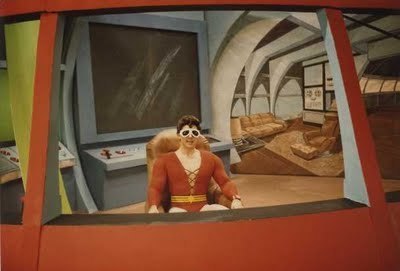 One thing I remember is indicative of what tickles me, the silliness, the stuff that goes for both kids and adults—I said something about my family and I can't quote you the exact dialogue. Something about "I'd like to intro you to my relatives, Plastic Cup, Plastic Fork, Plastic Wrap, and my funny uncle Aluminum Foil."
One thing I remember is indicative of what tickles me, the silliness, the stuff that goes for both kids and adults—I said something about my family and I can't quote you the exact dialogue. Something about "I'd like to intro you to my relatives, Plastic Cup, Plastic Fork, Plastic Wrap, and my funny uncle Aluminum Foil."
How did the Democratic National Convention gig come about?
My friend Jeff Wachtel went with me to the DNC. Now he's a Senior VP of Original Programming on USA. I don't watch much TV but apparently he's got several shows on USA that are pretty successful over the last 5-8 years.
There's something called the Living Newspaper that was done in the 1930s. I think it was a WPA project. Actors would get together and give the news of the day in radio form. Around 1980, Jeff got this idea with another lady, I guess. He was living in New York and they wanted to do another form of Living Newspaper, revive it. They mass-mailed a lot of contacts and one of the people that responded enthusiastically was Walter Cronkite. He wrote back his fond memories of that effort.
Jeff sent that letter along with his application for media credentials and got a couple of media passes for the 1980 DNC. He wanted to do it again in 1984 (when he didn't need Walter Cronkite anymore), with me, doing a little bit more zany and weird. He applied for the credentials again and got them. I had the character and outfit and he had the camera so [we said] let's just do this ambush on the DNC and see if we can make something fun.
I think Steve Whiting got the equipment. We had only two media credentials at a time so we had to swap off. Jeff lugged around 70 pounds of equipment and he's not a big guy. Created this guerrilla piece mostly for the fun of it.
So that wasn't with Steve?
As I remember it, Steve was there and Steve allowed it and made sure nothing blemished the character or image, but Steve wasn't the instigating force.
Do you remember if you were there all day?
Maybe a couple days. I remember Jesse Jackson, Walter Mondale.
Did you get any hassle?
I don't remember that. The trick was to get people to talk. I guess it's become more and more common with the advent of cable—what I call ambush videography. Like the guy from Kazakhstan [Borat]—he did it brilliantly. I did a more lame version of what he did so well.
Because we had legitimate press credentials, and there was a cameraman and Steve and I think another person, it added a bit of legitimacy. Nowadays with the abundance of college kids and everyone else crashing events with videocamera, it would raise more suspicion.
What other public appearances did you do as Plastic Man?
I did an appearance on P.M. Magazine. Off the top of my head those were the only two. A couple years we did the NATPE (National Association of Television Programming Executives) Convention. Everybody who sells syndication and buys syndication get together and make their deals. I was in costume and always in costume and I posed myself as doing security. Of course [that means] I'm the most suspicious-looking in the place! I basically patrolled.
A woman had just moved to San Francisco and was doing temp jobs and one of them was filling positions for this convention. She got a gig hosting the booth of [movie reviewers] Siskel and Ebert, hosting the clients. Now she's my wife of 23 years. She never saw me out of character [there]. I had a sidekick in a comedy troupe called Mr. Polyester and he broke character and said we're a comedy team and she could see us at such and such venue and she ended up doing that.
So first time you met her was in costume?
Yeah, and for two days, I never left character.
Did you want to continue in TV or film?
I'm an autonomous person. I liked stand-up. As a writer, maybe you like it, too—you can set your own time. I like that style as opposed to a lot of collaboration. I liked this because it was just me and Steve. But then I was with two small children and then I had a stroke. So between the two, I had responsibilities with the family on one hand and limitations in terms of processing speed on the other hand. I really don't have lingering wishes. In fact, about the only nightmare that I have is getting on stage in a comedy situation like I used to do all the time. My nightmare is getting ready to go on stage and remembering I had a stroke and can't talk the way I used to.
What are you doing these days?
Doing physical therapy. Several uncles and aunts in my family had AVMs (arteriovenous malformations). Because we had that in the family, I tested and I had it. My neurosurgeon said I can fix this but apparently he opened me up and found it more intricate and in more important brain matter and didn't want to remove it because would jeopardize too many of my abilities. But before he put my skull back he noticed I was hemorrhaging. So the surgery that was supposed to prevent all this kind of caused all this.
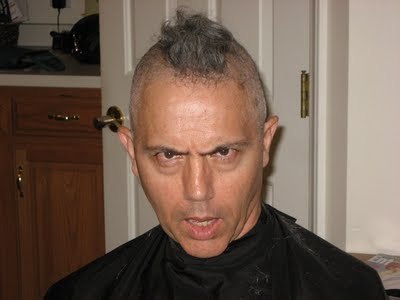
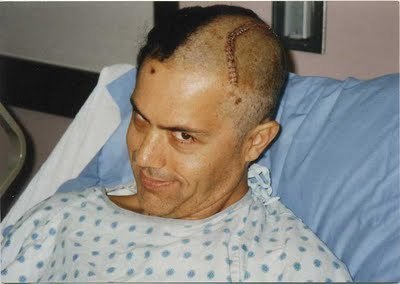
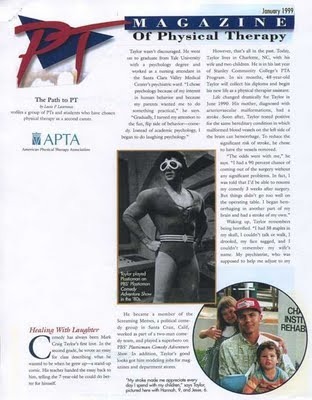 I woke up unable to speak and my right arm was totally flaccid. I couldn't read, write, or spell "cat." I did a lot of rehab.
I woke up unable to speak and my right arm was totally flaccid. I couldn't read, write, or spell "cat." I did a lot of rehab.
Once I could speak, read, and write again, I went back to school for physical therapy. I was doing comedy up until this surgery. I just wanted the challenge. I wanted the challenge to get back and do comedy again. With a lot of help from my speech therapist, and for about a year and a half on a lesser schedule, I performed stand-up around the country. Maybe the late '90s.
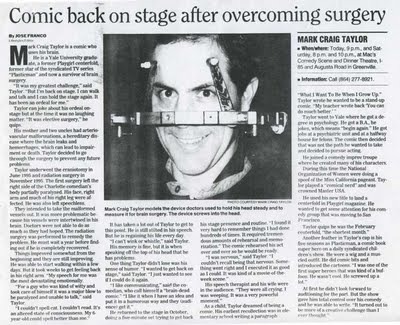 But at the same time, I knew my performance career was totally over and I was very inspired by the therapists who helped me. I went back and eventually worked at the rehab hospital I was a patient at.
But at the same time, I knew my performance career was totally over and I was very inspired by the therapists who helped me. I went back and eventually worked at the rehab hospital I was a patient at.
Still working at a hospital?
Still in PT realm. Now I'm at a retirement community where I help them walk, etc.
Can you drive?
I can drive. My walking is 100%. My arm, you can tell. My fine motor is affected.
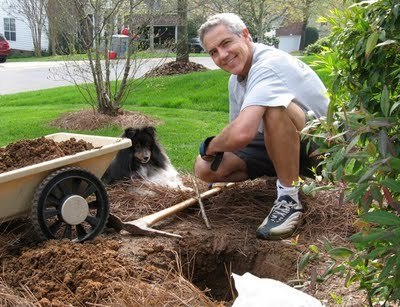 What are your children up to?
What are your children up to?
I have a daughter who's almost 22, junior at Chapel Hill. My son is 18, going to NC State.
What do they think of your time as a superhero?
Like a lot of parents [discover], my children couldn't give a whit about what they've done. I never wanted to push my stuff on them. My wife more than me introduced them to that at an appropriate age. It was very unimpressive to them. (laughs) I try not to take that personally.
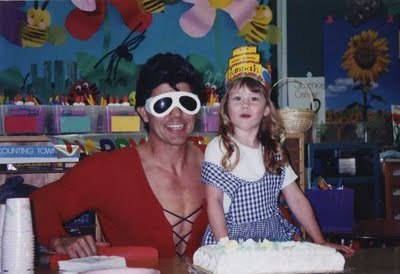 This 1994 birthday party for Mark's daughter was likely
This 1994 birthday party for Mark's daughter was likely
his last public appearance as Plastic Man.
Did you ever get letters from fans, and if so, do you still have any?
A little bit. It was hard to siphon through, get letters—a circuitous route: stations, etc. One guy in particular—I think he was maybe 14 and perhaps mentally or emotionally strange—and he was kind of stalking me with letters. He was very insistent with letters and photos. At first I would respond politely once or twice. But he was relentless so I had to stop.
Do you have any Plastic Man stuff?
I have the costume, which is deteriorating. I've got the pompadour wig, the glasses, the wristband communicator device. It was high-tech at the time.
Was there only one costume?
Yeah.
What about collectibles?
Friends over the years have given me miniature Plastic Man things, like part of a chess board game. And other kinds of kids' six- or eight-inch tall figures.
Had you seen any of your episodes since they went off the air?
I hadn't but I had a second brain surgery summer of 2008 (first one was 1995) so I had time off and I wanted to get my tape work onto DVD. So I was able to watch some of them. I didn't care to watch all of them. Some of them crack me up still in part because I know the difficulty of the time pressure. We didn't have weeks to write this stuff. I was pretty much jamming. I was so stoked. I couldn't sleep. I'd get up in the middle of the night "How about this bit, how about that bit?" It was a fertile time.
Has anyone else ever interviewed you about Plastic Man?
I got a lot of features as a comic written in newspapers. I have several things [that are somewhat] of note in my past, Plastic Man being one of them. Maybe he'd get a paragraph but never the focus.
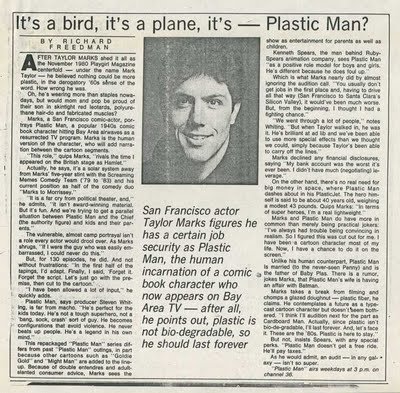 Memory can be deceiving!
Memory can be deceiving!
Examples of other things of note?
From New Haven (Yale '70-'74), I rode a bicycle across the country for half a year, didn't know what I wanted to do. I departed from New Haven July 4 and I arrived in San Jose about December 23. It was old school: cut-off jeans, suede sneakers, no helmet, no sunglasses, and in my backpack I hauled the I Ching to help with my decision-making. Worked my way to California: bike mechanic, sold flowers on street corners, pumped gas, sold my blood, sold souvenirs, etc.
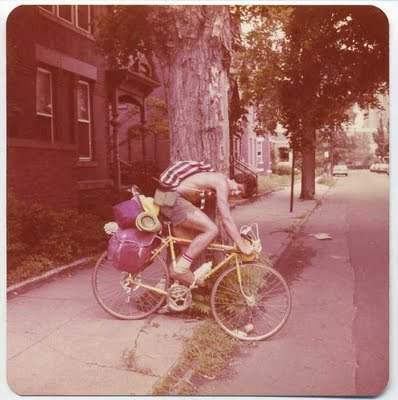
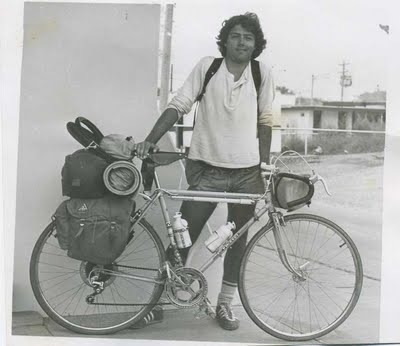 Frankly I hated Yale and wanted to get as far from reading and writing and that kind of lifestyle as I could. I think I borrowed $20 from my girlfriend and took off. They had kind of a media event when I returned home to San Jose.
Frankly I hated Yale and wanted to get as far from reading and writing and that kind of lifestyle as I could. I think I borrowed $20 from my girlfriend and took off. They had kind of a media event when I returned home to San Jose.
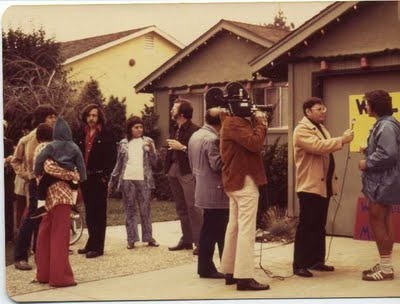 How did they find out about what you were doing?
How did they find out about what you were doing?
I think my mom talked to them. San Jose was kind of a smaller town then.
Other examples of note?
Once I was named one of the ten most eligible bachelors of San Francisco, around 1982, just before Plastic Man. I was a Playgirl centerfold once (11/80). I was married on the island of Bali. On a cliff at sunset with the full moon rising in 1986.
What does your wife do?
She's recently unemployed [as of mid-2010]. She was managing graphic artists for a financial institution—signage, PowerPoint.
How do you look back on your time on Plastic Man?
It was a small little thing. Just a little blip.
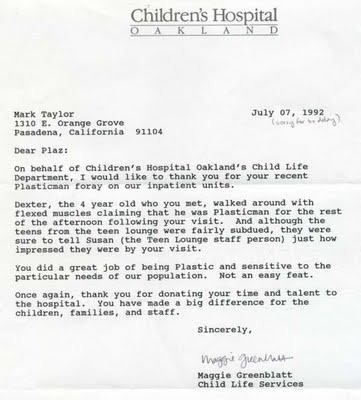 But I really liked it. It was very much a challenge. Most people wouldn't have seen it was a creative challenge as well as physically and verbally. It was an intense period that used my creativity to the max. You see it and say, "That's not Einstein, not genius," but when you consider the time constraints…I came to this in my mind almost without a script, scripts were just a backup.
But I really liked it. It was very much a challenge. Most people wouldn't have seen it was a creative challenge as well as physically and verbally. It was an intense period that used my creativity to the max. You see it and say, "That's not Einstein, not genius," but when you consider the time constraints…I came to this in my mind almost without a script, scripts were just a backup.
Where do you live now?
Charlotte, NC.
Did you move from San Francisco straight to Charlotte?
[After college], I went to Santa Cruz and got involved in a comedy troupe. Went to San Francisco. I split and did a solo to Los Angeles. I don't like Los Angeles and never did. I said to my wife, "I'll make you suffer only for five years, make or break it." After five years, I didn't make it and we had two very small kids and we wanted to be as close to family as possible. My wife had family in Charlotte and it had affordable housing. My family was in California but I couldn't afford to raise a family anywhere there where I wanted to be.
Have you ever participated (i.e. signed autographs) at a comic convention? If not, would you be willing to (if the convention paid your way)?
I haven't and would be open if anyone figures I would be of interest.
Anything else about the experience I didn't cover that you'd like to add?
Not about superheroes per se, but about a life change due to a man who played a superhero. It was interesting and humbling and somewhat traumatic that I went through a change where I was person who had some intellect, I was in shape, Playgirl thing, and then I was kind of humbled by my stroke and couldn't talk. My daughter was trying to teach me words again. Going to having it all to not having it all was…well, the words escape me, but it was transformative.
Christopher Reeve had his accident the same year.
As I recall there was a lot [about him] in the media when I was in the hospital.
His accident was end of May [1995].
I was June 15. I was down-to-Earth enough to know I wasn't all that, but when you have certain qualities that are pretty good and then you lose those qualities that are pretty good…I don't think I'm better for it. (laughs) A wiser person than me would say, "I learned a lot."
How long did it take you to learn to speak again?
It's a long process. Day by day. I was I think functional within a few months and then it got better. Even to this day if I get tired, stressed, nervous, it deteriorates momentarily and then fluctuates back. The frustration is felt daily, hourly, almost by the minute. But what I don't think I clearly articulated was the wonderful work "fate" has led me to. I'm now blessed to be able to help people who are afflicted like my mother and I were. Many people have told me that this is the work I was meant to do. We complete peace of mind, I agree. It's not Hollywood, but it is Super-work.
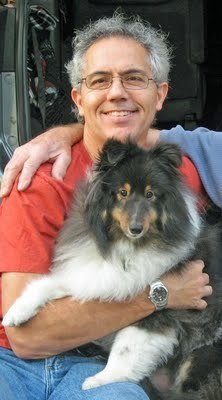
Next: Superman (1988 cartoon).
Introduction to subseries "The Plastic Man Comedy Adventure Show" (including list of interviewees).
Getting to know Mark Taylor was one of the most moving aspects of this experience for me. I will not elaborate because you will soon see why, but I will say that during our actual conversation, there was a lot of "Wow," "My gosh," "You are an inspiration," and the like from me. In transcribing, I have cut that out so you can mentally insert your own reactions as you read.
NOTE: Some of Mark's turns-of-a-phrase in e-mail showed that he was able to snap right back into Plastic Man mode. My favorite was a time when he had to reschedule a talk:
"You have to be flexible if you're going to deal with Plastic Man."
 How did you get the job on Plastic Man?
How did you get the job on Plastic Man?It's coincidental. I was doing comedy in San Francisco and doing a little acting, modeling, commercial work.
 One of my agents [told me that there was] an audition for this cartoon character. My interest was not at all in doing in a children's show. This was about an hour out of San Francisco. I declined to do it. Most auditions aren't fruitful. And then I realized that on the weekday afternoon of that audition I just happened to have a lunchtime college gig in that area. I thought, well, I'm in the area anyway so it was convenient. I called her back and said let's do it. They liked it and I got the job.
One of my agents [told me that there was] an audition for this cartoon character. My interest was not at all in doing in a children's show. This was about an hour out of San Francisco. I declined to do it. Most auditions aren't fruitful. And then I realized that on the weekday afternoon of that audition I just happened to have a lunchtime college gig in that area. I thought, well, I'm in the area anyway so it was convenient. I called her back and said let's do it. They liked it and I got the job.Do you remember what you had to do the for the audition?
I think I had to read script and see if I could get in the ballpark of that voice. They had a couple of different cartoon voices. I was looking for a voice similar to Don Adams's Get Smart. I was a fairly trim fit guy and if they just added a little shoulder muscle they could make a superhero out of me. It didn't take a lot of padding to make it happen.
How familiar were you with the character beforehand?
Not a whit. I knew Superman. I was a Superman fan. I didn't know anything about Plastic Man. Since then I've done a little bit of research and other people have told me. It was a kind of cult following. An alternative to the hyper-serious Superman and Batman. A whimsical [character], a comic screw-up.
How long did you have the job?
In terms of the work, only about six weeks because that's all we had to do it. Very short vignettes.
What challenges were involved in recording the show? (Related: do you remember any elements you or someone else wanted to include but which the network vetoed?)
There were a lot of challenges. First of all, you had to get it right on whatever time it was—22 or 44 seconds or whatever it was. I would have a clock right in front of me, and of course I had goggles. A lot of it was unscripted. I would have the idea that I wanted to do and I would try to get it in right. I thought [some of the scripts] spoke down to the kids.
Were you allowed to improvise/ad-lib?
[Producer/director] Steve Whiting was very collaborative. He was open to bringing some adult wackiness to it. So I wouldn't ad-lib as camera rolled. I would go with an idea pretty well formulated.
Mark as Plastic Man:
What segment is your favorite?
What I really liked about the gig was that it was a blank slate. I could do almost anything within taste. Plastic Man—you can make him whatever. Sometimes we'd do things with the camera that would be different—moving the camera so it would seem like the Plasti-Jet was going up or down, turbulence, breaking, crashing. None of that was in the original scripts. Those were just Plastic Man speaking straight to the camera as traditional as you can make it.
 One thing I remember is indicative of what tickles me, the silliness, the stuff that goes for both kids and adults—I said something about my family and I can't quote you the exact dialogue. Something about "I'd like to intro you to my relatives, Plastic Cup, Plastic Fork, Plastic Wrap, and my funny uncle Aluminum Foil."
One thing I remember is indicative of what tickles me, the silliness, the stuff that goes for both kids and adults—I said something about my family and I can't quote you the exact dialogue. Something about "I'd like to intro you to my relatives, Plastic Cup, Plastic Fork, Plastic Wrap, and my funny uncle Aluminum Foil."How did the Democratic National Convention gig come about?
My friend Jeff Wachtel went with me to the DNC. Now he's a Senior VP of Original Programming on USA. I don't watch much TV but apparently he's got several shows on USA that are pretty successful over the last 5-8 years.
There's something called the Living Newspaper that was done in the 1930s. I think it was a WPA project. Actors would get together and give the news of the day in radio form. Around 1980, Jeff got this idea with another lady, I guess. He was living in New York and they wanted to do another form of Living Newspaper, revive it. They mass-mailed a lot of contacts and one of the people that responded enthusiastically was Walter Cronkite. He wrote back his fond memories of that effort.
Jeff sent that letter along with his application for media credentials and got a couple of media passes for the 1980 DNC. He wanted to do it again in 1984 (when he didn't need Walter Cronkite anymore), with me, doing a little bit more zany and weird. He applied for the credentials again and got them. I had the character and outfit and he had the camera so [we said] let's just do this ambush on the DNC and see if we can make something fun.
I think Steve Whiting got the equipment. We had only two media credentials at a time so we had to swap off. Jeff lugged around 70 pounds of equipment and he's not a big guy. Created this guerrilla piece mostly for the fun of it.
So that wasn't with Steve?
As I remember it, Steve was there and Steve allowed it and made sure nothing blemished the character or image, but Steve wasn't the instigating force.
Do you remember if you were there all day?
Maybe a couple days. I remember Jesse Jackson, Walter Mondale.
Did you get any hassle?
I don't remember that. The trick was to get people to talk. I guess it's become more and more common with the advent of cable—what I call ambush videography. Like the guy from Kazakhstan [Borat]—he did it brilliantly. I did a more lame version of what he did so well.
Because we had legitimate press credentials, and there was a cameraman and Steve and I think another person, it added a bit of legitimacy. Nowadays with the abundance of college kids and everyone else crashing events with videocamera, it would raise more suspicion.
What other public appearances did you do as Plastic Man?
I did an appearance on P.M. Magazine. Off the top of my head those were the only two. A couple years we did the NATPE (National Association of Television Programming Executives) Convention. Everybody who sells syndication and buys syndication get together and make their deals. I was in costume and always in costume and I posed myself as doing security. Of course [that means] I'm the most suspicious-looking in the place! I basically patrolled.
A woman had just moved to San Francisco and was doing temp jobs and one of them was filling positions for this convention. She got a gig hosting the booth of [movie reviewers] Siskel and Ebert, hosting the clients. Now she's my wife of 23 years. She never saw me out of character [there]. I had a sidekick in a comedy troupe called Mr. Polyester and he broke character and said we're a comedy team and she could see us at such and such venue and she ended up doing that.
So first time you met her was in costume?
Yeah, and for two days, I never left character.
Did you want to continue in TV or film?
I'm an autonomous person. I liked stand-up. As a writer, maybe you like it, too—you can set your own time. I like that style as opposed to a lot of collaboration. I liked this because it was just me and Steve. But then I was with two small children and then I had a stroke. So between the two, I had responsibilities with the family on one hand and limitations in terms of processing speed on the other hand. I really don't have lingering wishes. In fact, about the only nightmare that I have is getting on stage in a comedy situation like I used to do all the time. My nightmare is getting ready to go on stage and remembering I had a stroke and can't talk the way I used to.
What are you doing these days?
Doing physical therapy. Several uncles and aunts in my family had AVMs (arteriovenous malformations). Because we had that in the family, I tested and I had it. My neurosurgeon said I can fix this but apparently he opened me up and found it more intricate and in more important brain matter and didn't want to remove it because would jeopardize too many of my abilities. But before he put my skull back he noticed I was hemorrhaging. So the surgery that was supposed to prevent all this kind of caused all this.


 I woke up unable to speak and my right arm was totally flaccid. I couldn't read, write, or spell "cat." I did a lot of rehab.
I woke up unable to speak and my right arm was totally flaccid. I couldn't read, write, or spell "cat." I did a lot of rehab. Once I could speak, read, and write again, I went back to school for physical therapy. I was doing comedy up until this surgery. I just wanted the challenge. I wanted the challenge to get back and do comedy again. With a lot of help from my speech therapist, and for about a year and a half on a lesser schedule, I performed stand-up around the country. Maybe the late '90s.
 But at the same time, I knew my performance career was totally over and I was very inspired by the therapists who helped me. I went back and eventually worked at the rehab hospital I was a patient at.
But at the same time, I knew my performance career was totally over and I was very inspired by the therapists who helped me. I went back and eventually worked at the rehab hospital I was a patient at.Still working at a hospital?
Still in PT realm. Now I'm at a retirement community where I help them walk, etc.
Can you drive?
I can drive. My walking is 100%. My arm, you can tell. My fine motor is affected.
 What are your children up to?
What are your children up to?I have a daughter who's almost 22, junior at Chapel Hill. My son is 18, going to NC State.
What do they think of your time as a superhero?
Like a lot of parents [discover], my children couldn't give a whit about what they've done. I never wanted to push my stuff on them. My wife more than me introduced them to that at an appropriate age. It was very unimpressive to them. (laughs) I try not to take that personally.
 This 1994 birthday party for Mark's daughter was likely
This 1994 birthday party for Mark's daughter was likelyhis last public appearance as Plastic Man.
Did you ever get letters from fans, and if so, do you still have any?
A little bit. It was hard to siphon through, get letters—a circuitous route: stations, etc. One guy in particular—I think he was maybe 14 and perhaps mentally or emotionally strange—and he was kind of stalking me with letters. He was very insistent with letters and photos. At first I would respond politely once or twice. But he was relentless so I had to stop.
Do you have any Plastic Man stuff?
I have the costume, which is deteriorating. I've got the pompadour wig, the glasses, the wristband communicator device. It was high-tech at the time.
Was there only one costume?
Yeah.
What about collectibles?
Friends over the years have given me miniature Plastic Man things, like part of a chess board game. And other kinds of kids' six- or eight-inch tall figures.
Had you seen any of your episodes since they went off the air?
I hadn't but I had a second brain surgery summer of 2008 (first one was 1995) so I had time off and I wanted to get my tape work onto DVD. So I was able to watch some of them. I didn't care to watch all of them. Some of them crack me up still in part because I know the difficulty of the time pressure. We didn't have weeks to write this stuff. I was pretty much jamming. I was so stoked. I couldn't sleep. I'd get up in the middle of the night "How about this bit, how about that bit?" It was a fertile time.
Has anyone else ever interviewed you about Plastic Man?
I got a lot of features as a comic written in newspapers. I have several things [that are somewhat] of note in my past, Plastic Man being one of them. Maybe he'd get a paragraph but never the focus.
 Memory can be deceiving!
Memory can be deceiving!Examples of other things of note?
From New Haven (Yale '70-'74), I rode a bicycle across the country for half a year, didn't know what I wanted to do. I departed from New Haven July 4 and I arrived in San Jose about December 23. It was old school: cut-off jeans, suede sneakers, no helmet, no sunglasses, and in my backpack I hauled the I Ching to help with my decision-making. Worked my way to California: bike mechanic, sold flowers on street corners, pumped gas, sold my blood, sold souvenirs, etc.

 Frankly I hated Yale and wanted to get as far from reading and writing and that kind of lifestyle as I could. I think I borrowed $20 from my girlfriend and took off. They had kind of a media event when I returned home to San Jose.
Frankly I hated Yale and wanted to get as far from reading and writing and that kind of lifestyle as I could. I think I borrowed $20 from my girlfriend and took off. They had kind of a media event when I returned home to San Jose. How did they find out about what you were doing?
How did they find out about what you were doing?I think my mom talked to them. San Jose was kind of a smaller town then.
Other examples of note?
Once I was named one of the ten most eligible bachelors of San Francisco, around 1982, just before Plastic Man. I was a Playgirl centerfold once (11/80). I was married on the island of Bali. On a cliff at sunset with the full moon rising in 1986.
What does your wife do?
She's recently unemployed [as of mid-2010]. She was managing graphic artists for a financial institution—signage, PowerPoint.
How do you look back on your time on Plastic Man?
It was a small little thing. Just a little blip.
 But I really liked it. It was very much a challenge. Most people wouldn't have seen it was a creative challenge as well as physically and verbally. It was an intense period that used my creativity to the max. You see it and say, "That's not Einstein, not genius," but when you consider the time constraints…I came to this in my mind almost without a script, scripts were just a backup.
But I really liked it. It was very much a challenge. Most people wouldn't have seen it was a creative challenge as well as physically and verbally. It was an intense period that used my creativity to the max. You see it and say, "That's not Einstein, not genius," but when you consider the time constraints…I came to this in my mind almost without a script, scripts were just a backup.Where do you live now?
Charlotte, NC.
Did you move from San Francisco straight to Charlotte?
[After college], I went to Santa Cruz and got involved in a comedy troupe. Went to San Francisco. I split and did a solo to Los Angeles. I don't like Los Angeles and never did. I said to my wife, "I'll make you suffer only for five years, make or break it." After five years, I didn't make it and we had two very small kids and we wanted to be as close to family as possible. My wife had family in Charlotte and it had affordable housing. My family was in California but I couldn't afford to raise a family anywhere there where I wanted to be.
Have you ever participated (i.e. signed autographs) at a comic convention? If not, would you be willing to (if the convention paid your way)?
I haven't and would be open if anyone figures I would be of interest.
Anything else about the experience I didn't cover that you'd like to add?
Not about superheroes per se, but about a life change due to a man who played a superhero. It was interesting and humbling and somewhat traumatic that I went through a change where I was person who had some intellect, I was in shape, Playgirl thing, and then I was kind of humbled by my stroke and couldn't talk. My daughter was trying to teach me words again. Going to having it all to not having it all was…well, the words escape me, but it was transformative.
Christopher Reeve had his accident the same year.
As I recall there was a lot [about him] in the media when I was in the hospital.
His accident was end of May [1995].
I was June 15. I was down-to-Earth enough to know I wasn't all that, but when you have certain qualities that are pretty good and then you lose those qualities that are pretty good…I don't think I'm better for it. (laughs) A wiser person than me would say, "I learned a lot."
How long did it take you to learn to speak again?
It's a long process. Day by day. I was I think functional within a few months and then it got better. Even to this day if I get tired, stressed, nervous, it deteriorates momentarily and then fluctuates back. The frustration is felt daily, hourly, almost by the minute. But what I don't think I clearly articulated was the wonderful work "fate" has led me to. I'm now blessed to be able to help people who are afflicted like my mother and I were. Many people have told me that this is the work I was meant to do. We complete peace of mind, I agree. It's not Hollywood, but it is Super-work.

Next: Superman (1988 cartoon).
Published on October 01, 2011 04:58
Super '70s and '80s: "The Plastic Man Comedy Show"—Mark Taylor (Plastic Man—live action)
Introduction to series "Super '70s and '80s."
Introduction to subseries "The Plastic Man Comedy Show" (including list of interviewees).
Getting to know Mark Taylor was one of the most moving aspects of this experience for me. I will not elaborate because you will soon see why, but I will say that during our actual conversation, there was a lot of "Wow," "My gosh," "You are an inspiration," and the like from me. In transcribing, I have cut that out so you can mentally insert your own reactions as you read.
NOTE: Some of Mark's turns-of-a-phrase in e-mail showed that he was able to snap right back into Plastic Man mode. My favorite was a time when he had to reschedule a talk:
"You have to be flexible if you're going to deal with Plastic Man."
 How did you get the job on Plastic Man?
How did you get the job on Plastic Man?
It's coincidental. I was doing comedy in San Francisco and doing a little acting, modeling, commercial work.
 One of my agents [told me that there was] an audition for this cartoon character. My interest was not at all in doing in a children's show. This was about an hour out of San Francisco. I declined to do it. Most auditions aren't fruitful. And then I realized that on the weekday afternoon of that audition I just happened to have a lunchtime college gig in that area. I thought, well, I'm in the area anyway so it was convenient. I called her back and said let's do it. They liked it and I got the job.
One of my agents [told me that there was] an audition for this cartoon character. My interest was not at all in doing in a children's show. This was about an hour out of San Francisco. I declined to do it. Most auditions aren't fruitful. And then I realized that on the weekday afternoon of that audition I just happened to have a lunchtime college gig in that area. I thought, well, I'm in the area anyway so it was convenient. I called her back and said let's do it. They liked it and I got the job.
Do you remember what you had to do the for the audition?
I think I had to read script and see if I could get in the ballpark of that voice. They had a couple of different cartoon voices. I was looking for a voice similar to Don Adams's Get Smart. I was a fairly trim fit guy and if they just added a little shoulder muscle they could make a superhero out of me. It didn't take a lot of padding to make it happen.
How familiar were you with the character beforehand?
Not a whit. I knew Superman. I was a Superman fan. I didn't know anything about Plastic Man. Since then I've done a little bit of research and other people have told me. It was a kind of cult following. An alternative to the hyper-serious Superman and Batman. A whimsical [character], a comic screw-up.
How long did you have the job?
In terms of the work, only about six weeks because that's all we had to do it. Very short vignettes.
What challenges were involved in recording the show? (Related: do you remember any elements you or someone else wanted to include but which the network vetoed?)
There were a lot of challenges. First of all, you had to get it right on whatever time it was—22 or 44 seconds or whatever it was. I would have a clock right in front of me, and of course I had goggles. A lot of it was unscripted. I would have the idea that I wanted to do and I would try to get it in right. I thought [some of the scripts] spoke down to the kids.
Were you allowed to improvise/ad-lib?
[Producer/director] Steve Whiting was very collaborative. He was open to bringing some adult wackiness to it. So I wouldn't ad-lib as camera rolled. I would go with an idea pretty well formulated.
Mark as Plastic Man:
What segment is your favorite?
What I really liked about the gig was that it was a blank slate. I could do almost anything within taste. Plastic Man—you can make him whatever. Sometimes we'd do things with the camera that would be different—moving the camera so it would seem like the Plasti-Jet was going up or down, turbulence, breaking, crashing. None of that was in the original scripts. Those were just Plastic Man speaking straight to the camera as traditional as you can make it.
 One thing I remember is indicative of what tickles me, the silliness, the stuff that goes for both kids and adults—I said something about my family and I can't quote you the exact dialogue. Something about "I'd like to intro you to my relatives, Plastic Cup, Plastic Fork, Plastic Wrap, and my funny uncle Aluminum Foil."
One thing I remember is indicative of what tickles me, the silliness, the stuff that goes for both kids and adults—I said something about my family and I can't quote you the exact dialogue. Something about "I'd like to intro you to my relatives, Plastic Cup, Plastic Fork, Plastic Wrap, and my funny uncle Aluminum Foil."
How did the Democratic National Convention gig come about?
My friend Jeff Wachtel went with me to the DNC. Now he's a Senior VP of Original Programming on USA. I don't watch much TV but apparently he's got several shows on USA that are pretty successful over the last 5-8 years.
There's something called the Living Newspaper that was done in the 1930s. I think it was a WPA project. Actors would get together and give the news of the day in radio form. Around 1980, Jeff got this idea with another lady, I guess. He was living in New York and they wanted to do another form of Living Newspaper, revive it. They mass-mailed a lot of contacts and one of the people that responded enthusiastically was Walter Cronkite. He wrote back his fond memories of that effort.
Jeff sent that letter along with his application for media credentials and got a couple of media passes for the 1980 DNC. He wanted to do it again in 1984 (when he didn't need Walter Cronkite anymore), with me, doing a little bit more zany and weird. He applied for the credentials again and got them. I had the character and outfit and he had the camera so [we said] let's just do this ambush on the DNC and see if we can make something fun.
I think Steve Whiting got the equipment. We had only two media credentials at a time so we had to swap off. Jeff lugged around 70 pounds of equipment and he's not a big guy. Created this guerrilla piece mostly for the fun of it.
So that wasn't with Steve?
As I remember it, Steve was there and Steve allowed it and made sure nothing blemished the character or image, but Steve wasn't the instigating force.
Do you remember if you were there all day?
Maybe a couple days. I remember Jesse Jackson, Walter Mondale.
Did you get any hassle?
I don't remember that. The trick was to get people to talk. I guess it's become more and more common with the advent of cable—what I call ambush videography. Like the guy from Kazakhstan [Borat]—he did it brilliantly. I did a more lame version of what he did so well.
Because we had legitimate press credentials, and there was a cameraman and Steve and I think another person, it added a bit of legitimacy. Nowadays with the abundance of college kids and everyone else crashing events with videocamera, it would raise more suspicion.
What other public appearances did you do as Plastic Man?
I did an appearance on P.M. Magazine. Off the top of my head those were the only two. A couple years we did the NATPE (National Association of Television Programming Executives) Convention. Everybody who sells syndication and buys syndication get together and make their deals. I was in costume and always in costume and I posed myself as doing security. Of course [that means] I'm the most suspicious-looking in the place! I basically patrolled.
A woman had just moved to San Francisco and was doing temp jobs and one of them was filling positions for this convention. She got a gig hosting the booth of [movie reviewers] Siskel and Ebert, hosting the clients. Now she's my wife of 23 years. She never saw me out of character [there]. I had a sidekick in a comedy troupe called Mr. Polyester and he broke character and said we're a comedy team and she could see us at such and such venue and she ended up doing that.
So first time you met her was in costume?
Yeah, and for two days, I never left character.
Did you want to continue in TV or film?
I'm an autonomous person. I liked stand-up. As a writer, maybe you like it, too—you can set your own time. I like that style as opposed to a lot of collaboration. I liked this because it was just me and Steve. But then I was with two small children and then I had a stroke. So between the two, I had responsibilities with the family on one hand and limitations in terms of processing speed on the other hand. I really don't have lingering wishes. In fact, about the only nightmare that I have is getting on stage in a comedy situation like I used to do all the time. My nightmare is getting ready to go on stage and remembering I had a stroke and can't talk the way I used to.
What are you doing these days?
Doing physical therapy. Several uncles and aunts in my family had AVMs (arteriovenous malformations). Because we had that in the family, I tested and I had it. My neurosurgeon said I can fix this but apparently he opened me up and found it more intricate and in more important brain matter and didn't want to remove it because would jeopardize too many of my abilities. But before he put my skull back he noticed I was hemorrhaging. So the surgery that was supposed to prevent all this kind of caused all this.


 I woke up unable to speak and my right arm was totally flaccid. I couldn't read, write, or spell "cat." I did a lot of rehab.
I woke up unable to speak and my right arm was totally flaccid. I couldn't read, write, or spell "cat." I did a lot of rehab.
Once I could speak, read, and write again, I went back to school for physical therapy. I was doing comedy up until this surgery. I just wanted the challenge. I wanted the challenge to get back and do comedy again. With a lot of help from my speech therapist, and for about a year and a half on a lesser schedule, I performed stand-up around the country. Maybe the late '90s.
 But at the same time, I knew my performance career was totally over and I was very inspired by the therapists who helped me. I went back and eventually worked at the rehab hospital I was a patient at.
But at the same time, I knew my performance career was totally over and I was very inspired by the therapists who helped me. I went back and eventually worked at the rehab hospital I was a patient at.
Still working at a hospital?
Still in PT realm. Now I'm at a retirement community where I help them walk, etc.
Can you drive?
I can drive. My walking is 100%. My arm, you can tell. My fine motor is affected.
 What are your children up to?
What are your children up to?
I have a daughter who's almost 22, junior at Chapel Hill. My son is 18, going to NC State.
What do they think of your time as a superhero?
Like a lot of parents [discover], my children couldn't give a whit about what they've done. I never wanted to push my stuff on them. My wife more than me introduced them to that at an appropriate age. It was very unimpressive to them. (laughs) I try not to take that personally.
 This 1994 birthday party for Mark's daughter was likely
This 1994 birthday party for Mark's daughter was likely
his last public appearance as Plastic Man.
Did you ever get letters from fans, and if so, do you still have any?
A little bit. It was hard to siphon through, get letters—a circuitous route: stations, etc. One guy in particular—I think he was maybe 14 and perhaps mentally or emotionally strange—and he was kind of stalking me with letters. He was very insistent with letters and photos. At first I would respond politely once or twice. But he was relentless so I had to stop.
Do you have any Plastic Man stuff?
I have the costume, which is deteriorating. I've got the pompadour wig, the glasses, the wristband communicator device. It was high-tech at the time.
Was there only one costume?
Yeah.
What about collectibles?
Friends over the years have given me miniature Plastic Man things, like part of a chess board game. And other kinds of kids' six- or eight-inch tall figures.
Had you seen any of your episodes since they went off the air?
I hadn't but I had a second brain surgery summer of 2008 (first one was 1995) so I had time off and I wanted to get my tape work onto DVD. So I was able to watch some of them. I didn't care to watch all of them. Some of them crack me up still in part because I know the difficulty of the time pressure. We didn't have weeks to write this stuff. I was pretty much jamming. I was so stoked. I couldn't sleep. I'd get up in the middle of the night "How about this bit, how about that bit?" It was a fertile time.
Has anyone else ever interviewed you about Plastic Man?
I got a lot of features as a comic written in newspapers. I have several things [that are somewhat] of note in my past, Plastic Man being one of them. Maybe he'd get a paragraph but never the focus.
 Memory can be deceiving!
Memory can be deceiving!
Examples of other things of note?
From New Haven (Yale '70-'74), I rode a bicycle across the country for half a year, didn't know what I wanted to do. I departed from New Haven July 4 and I arrived in San Jose about December 23. It was old school: cut-off jeans, suede sneakers, no helmet, no sunglasses, and in my backpack I hauled the I Ching to help with my decision-making. Worked my way to California: bike mechanic, sold flowers on street corners, pumped gas, sold my blood, sold souvenirs, etc.

 Frankly I hated Yale and wanted to get as far from reading and writing and that kind of lifestyle as I could. I think I borrowed $20 from my girlfriend and took off. They had kind of a media event when I returned home to San Jose.
Frankly I hated Yale and wanted to get as far from reading and writing and that kind of lifestyle as I could. I think I borrowed $20 from my girlfriend and took off. They had kind of a media event when I returned home to San Jose.
 How did they find out about what you were doing?
How did they find out about what you were doing?
I think my mom talked to them. San Jose was kind of a smaller town then.
Other examples of note?
Once I was named one of the ten most eligible bachelors of San Francisco, around 1982, just before Plastic Man. I was a Playgirl centerfold once (11/80). I was married on the island of Bali. On a cliff at sunset with the full moon rising in 1986.
What does your wife do?
She's recently unemployed [as of mid-2010]. She was managing graphic artists for a financial institution—signage, PowerPoint.
How do you look back on your time on Plastic Man?
It was a small little thing. Just a little blip.
 But I really liked it. It was very much a challenge. Most people wouldn't have seen it was a creative challenge as well as physically and verbally. It was an intense period that used my creativity to the max. You see it and say, "That's not Einstein, not genius," but when you consider the time constraints…I came to this in my mind almost without a script, scripts were just a backup.
But I really liked it. It was very much a challenge. Most people wouldn't have seen it was a creative challenge as well as physically and verbally. It was an intense period that used my creativity to the max. You see it and say, "That's not Einstein, not genius," but when you consider the time constraints…I came to this in my mind almost without a script, scripts were just a backup.
Where do you live now?
Charlotte, NC.
Did you move from San Francisco straight to Charlotte?
[After college], I went to Santa Cruz and got involved in a comedy troupe. Went to San Francisco. I split and did a solo to Los Angeles. I don't like Los Angeles and never did. I said to my wife, "I'll make you suffer only for five years, make or break it." After five years, I didn't make it and we had two very small kids and we wanted to be as close to family as possible. My wife had family in Charlotte and it had affordable housing. My family was in California but I couldn't afford to raise a family anywhere there where I wanted to be.
Have you ever participated (i.e. signed autographs) at a comic convention? If not, would you be willing to (if the convention paid your way)?
I haven't and would be open if anyone figures I would be of interest.
Anything else about the experience I didn't cover that you'd like to add?
Not about superheroes per se, but about a life change due to a man who played a superhero. It was interesting and humbling and somewhat traumatic that I went through a change where I was person who had some intellect, I was in shape, Playgirl thing, and then I was kind of humbled by my stroke and couldn't talk. My daughter was trying to teach me words again. Going to having it all to not having it all was…well, the words escape me, but it was transformative.
Christopher Reeve had his accident the same year.
As I recall there was a lot [about him] in the media when I was in the hospital.
His accident was end of May [1995].
I was June 15. I was down-to-Earth enough to know I wasn't all that, but when you have certain qualities that are pretty good and then you lose those qualities that are pretty good…I don't think I'm better for it. (laughs) A wiser person than me would say, "I learned a lot."
How long did it take you to learn to speak again?
It's a long process. Day by day. I was I think functional within a few months and then it got better. Even to this day if I get tired, stressed, nervous, it deteriorates momentarily and then fluctuates back. The frustration is felt daily, hourly, almost by the minute. But what I don't think I clearly articulated was the wonderful work "fate" has led me to. I'm now blessed to be able to help people who are afflicted like my mother and I were. Many people have told me that this is the work I was meant to do. We complete peace of mind, I agree. It's not Hollywood, but it is Super-work.

Next: Superman (1988 cartoon).
Introduction to subseries "The Plastic Man Comedy Show" (including list of interviewees).
Getting to know Mark Taylor was one of the most moving aspects of this experience for me. I will not elaborate because you will soon see why, but I will say that during our actual conversation, there was a lot of "Wow," "My gosh," "You are an inspiration," and the like from me. In transcribing, I have cut that out so you can mentally insert your own reactions as you read.
NOTE: Some of Mark's turns-of-a-phrase in e-mail showed that he was able to snap right back into Plastic Man mode. My favorite was a time when he had to reschedule a talk:
"You have to be flexible if you're going to deal with Plastic Man."
 How did you get the job on Plastic Man?
How did you get the job on Plastic Man?It's coincidental. I was doing comedy in San Francisco and doing a little acting, modeling, commercial work.
 One of my agents [told me that there was] an audition for this cartoon character. My interest was not at all in doing in a children's show. This was about an hour out of San Francisco. I declined to do it. Most auditions aren't fruitful. And then I realized that on the weekday afternoon of that audition I just happened to have a lunchtime college gig in that area. I thought, well, I'm in the area anyway so it was convenient. I called her back and said let's do it. They liked it and I got the job.
One of my agents [told me that there was] an audition for this cartoon character. My interest was not at all in doing in a children's show. This was about an hour out of San Francisco. I declined to do it. Most auditions aren't fruitful. And then I realized that on the weekday afternoon of that audition I just happened to have a lunchtime college gig in that area. I thought, well, I'm in the area anyway so it was convenient. I called her back and said let's do it. They liked it and I got the job.Do you remember what you had to do the for the audition?
I think I had to read script and see if I could get in the ballpark of that voice. They had a couple of different cartoon voices. I was looking for a voice similar to Don Adams's Get Smart. I was a fairly trim fit guy and if they just added a little shoulder muscle they could make a superhero out of me. It didn't take a lot of padding to make it happen.
How familiar were you with the character beforehand?
Not a whit. I knew Superman. I was a Superman fan. I didn't know anything about Plastic Man. Since then I've done a little bit of research and other people have told me. It was a kind of cult following. An alternative to the hyper-serious Superman and Batman. A whimsical [character], a comic screw-up.
How long did you have the job?
In terms of the work, only about six weeks because that's all we had to do it. Very short vignettes.
What challenges were involved in recording the show? (Related: do you remember any elements you or someone else wanted to include but which the network vetoed?)
There were a lot of challenges. First of all, you had to get it right on whatever time it was—22 or 44 seconds or whatever it was. I would have a clock right in front of me, and of course I had goggles. A lot of it was unscripted. I would have the idea that I wanted to do and I would try to get it in right. I thought [some of the scripts] spoke down to the kids.
Were you allowed to improvise/ad-lib?
[Producer/director] Steve Whiting was very collaborative. He was open to bringing some adult wackiness to it. So I wouldn't ad-lib as camera rolled. I would go with an idea pretty well formulated.
Mark as Plastic Man:
What segment is your favorite?
What I really liked about the gig was that it was a blank slate. I could do almost anything within taste. Plastic Man—you can make him whatever. Sometimes we'd do things with the camera that would be different—moving the camera so it would seem like the Plasti-Jet was going up or down, turbulence, breaking, crashing. None of that was in the original scripts. Those were just Plastic Man speaking straight to the camera as traditional as you can make it.
 One thing I remember is indicative of what tickles me, the silliness, the stuff that goes for both kids and adults—I said something about my family and I can't quote you the exact dialogue. Something about "I'd like to intro you to my relatives, Plastic Cup, Plastic Fork, Plastic Wrap, and my funny uncle Aluminum Foil."
One thing I remember is indicative of what tickles me, the silliness, the stuff that goes for both kids and adults—I said something about my family and I can't quote you the exact dialogue. Something about "I'd like to intro you to my relatives, Plastic Cup, Plastic Fork, Plastic Wrap, and my funny uncle Aluminum Foil."How did the Democratic National Convention gig come about?
My friend Jeff Wachtel went with me to the DNC. Now he's a Senior VP of Original Programming on USA. I don't watch much TV but apparently he's got several shows on USA that are pretty successful over the last 5-8 years.
There's something called the Living Newspaper that was done in the 1930s. I think it was a WPA project. Actors would get together and give the news of the day in radio form. Around 1980, Jeff got this idea with another lady, I guess. He was living in New York and they wanted to do another form of Living Newspaper, revive it. They mass-mailed a lot of contacts and one of the people that responded enthusiastically was Walter Cronkite. He wrote back his fond memories of that effort.
Jeff sent that letter along with his application for media credentials and got a couple of media passes for the 1980 DNC. He wanted to do it again in 1984 (when he didn't need Walter Cronkite anymore), with me, doing a little bit more zany and weird. He applied for the credentials again and got them. I had the character and outfit and he had the camera so [we said] let's just do this ambush on the DNC and see if we can make something fun.
I think Steve Whiting got the equipment. We had only two media credentials at a time so we had to swap off. Jeff lugged around 70 pounds of equipment and he's not a big guy. Created this guerrilla piece mostly for the fun of it.
So that wasn't with Steve?
As I remember it, Steve was there and Steve allowed it and made sure nothing blemished the character or image, but Steve wasn't the instigating force.
Do you remember if you were there all day?
Maybe a couple days. I remember Jesse Jackson, Walter Mondale.
Did you get any hassle?
I don't remember that. The trick was to get people to talk. I guess it's become more and more common with the advent of cable—what I call ambush videography. Like the guy from Kazakhstan [Borat]—he did it brilliantly. I did a more lame version of what he did so well.
Because we had legitimate press credentials, and there was a cameraman and Steve and I think another person, it added a bit of legitimacy. Nowadays with the abundance of college kids and everyone else crashing events with videocamera, it would raise more suspicion.
What other public appearances did you do as Plastic Man?
I did an appearance on P.M. Magazine. Off the top of my head those were the only two. A couple years we did the NATPE (National Association of Television Programming Executives) Convention. Everybody who sells syndication and buys syndication get together and make their deals. I was in costume and always in costume and I posed myself as doing security. Of course [that means] I'm the most suspicious-looking in the place! I basically patrolled.
A woman had just moved to San Francisco and was doing temp jobs and one of them was filling positions for this convention. She got a gig hosting the booth of [movie reviewers] Siskel and Ebert, hosting the clients. Now she's my wife of 23 years. She never saw me out of character [there]. I had a sidekick in a comedy troupe called Mr. Polyester and he broke character and said we're a comedy team and she could see us at such and such venue and she ended up doing that.
So first time you met her was in costume?
Yeah, and for two days, I never left character.
Did you want to continue in TV or film?
I'm an autonomous person. I liked stand-up. As a writer, maybe you like it, too—you can set your own time. I like that style as opposed to a lot of collaboration. I liked this because it was just me and Steve. But then I was with two small children and then I had a stroke. So between the two, I had responsibilities with the family on one hand and limitations in terms of processing speed on the other hand. I really don't have lingering wishes. In fact, about the only nightmare that I have is getting on stage in a comedy situation like I used to do all the time. My nightmare is getting ready to go on stage and remembering I had a stroke and can't talk the way I used to.
What are you doing these days?
Doing physical therapy. Several uncles and aunts in my family had AVMs (arteriovenous malformations). Because we had that in the family, I tested and I had it. My neurosurgeon said I can fix this but apparently he opened me up and found it more intricate and in more important brain matter and didn't want to remove it because would jeopardize too many of my abilities. But before he put my skull back he noticed I was hemorrhaging. So the surgery that was supposed to prevent all this kind of caused all this.


 I woke up unable to speak and my right arm was totally flaccid. I couldn't read, write, or spell "cat." I did a lot of rehab.
I woke up unable to speak and my right arm was totally flaccid. I couldn't read, write, or spell "cat." I did a lot of rehab. Once I could speak, read, and write again, I went back to school for physical therapy. I was doing comedy up until this surgery. I just wanted the challenge. I wanted the challenge to get back and do comedy again. With a lot of help from my speech therapist, and for about a year and a half on a lesser schedule, I performed stand-up around the country. Maybe the late '90s.
 But at the same time, I knew my performance career was totally over and I was very inspired by the therapists who helped me. I went back and eventually worked at the rehab hospital I was a patient at.
But at the same time, I knew my performance career was totally over and I was very inspired by the therapists who helped me. I went back and eventually worked at the rehab hospital I was a patient at.Still working at a hospital?
Still in PT realm. Now I'm at a retirement community where I help them walk, etc.
Can you drive?
I can drive. My walking is 100%. My arm, you can tell. My fine motor is affected.
 What are your children up to?
What are your children up to?I have a daughter who's almost 22, junior at Chapel Hill. My son is 18, going to NC State.
What do they think of your time as a superhero?
Like a lot of parents [discover], my children couldn't give a whit about what they've done. I never wanted to push my stuff on them. My wife more than me introduced them to that at an appropriate age. It was very unimpressive to them. (laughs) I try not to take that personally.
 This 1994 birthday party for Mark's daughter was likely
This 1994 birthday party for Mark's daughter was likelyhis last public appearance as Plastic Man.
Did you ever get letters from fans, and if so, do you still have any?
A little bit. It was hard to siphon through, get letters—a circuitous route: stations, etc. One guy in particular—I think he was maybe 14 and perhaps mentally or emotionally strange—and he was kind of stalking me with letters. He was very insistent with letters and photos. At first I would respond politely once or twice. But he was relentless so I had to stop.
Do you have any Plastic Man stuff?
I have the costume, which is deteriorating. I've got the pompadour wig, the glasses, the wristband communicator device. It was high-tech at the time.
Was there only one costume?
Yeah.
What about collectibles?
Friends over the years have given me miniature Plastic Man things, like part of a chess board game. And other kinds of kids' six- or eight-inch tall figures.
Had you seen any of your episodes since they went off the air?
I hadn't but I had a second brain surgery summer of 2008 (first one was 1995) so I had time off and I wanted to get my tape work onto DVD. So I was able to watch some of them. I didn't care to watch all of them. Some of them crack me up still in part because I know the difficulty of the time pressure. We didn't have weeks to write this stuff. I was pretty much jamming. I was so stoked. I couldn't sleep. I'd get up in the middle of the night "How about this bit, how about that bit?" It was a fertile time.
Has anyone else ever interviewed you about Plastic Man?
I got a lot of features as a comic written in newspapers. I have several things [that are somewhat] of note in my past, Plastic Man being one of them. Maybe he'd get a paragraph but never the focus.
 Memory can be deceiving!
Memory can be deceiving!Examples of other things of note?
From New Haven (Yale '70-'74), I rode a bicycle across the country for half a year, didn't know what I wanted to do. I departed from New Haven July 4 and I arrived in San Jose about December 23. It was old school: cut-off jeans, suede sneakers, no helmet, no sunglasses, and in my backpack I hauled the I Ching to help with my decision-making. Worked my way to California: bike mechanic, sold flowers on street corners, pumped gas, sold my blood, sold souvenirs, etc.

 Frankly I hated Yale and wanted to get as far from reading and writing and that kind of lifestyle as I could. I think I borrowed $20 from my girlfriend and took off. They had kind of a media event when I returned home to San Jose.
Frankly I hated Yale and wanted to get as far from reading and writing and that kind of lifestyle as I could. I think I borrowed $20 from my girlfriend and took off. They had kind of a media event when I returned home to San Jose. How did they find out about what you were doing?
How did they find out about what you were doing?I think my mom talked to them. San Jose was kind of a smaller town then.
Other examples of note?
Once I was named one of the ten most eligible bachelors of San Francisco, around 1982, just before Plastic Man. I was a Playgirl centerfold once (11/80). I was married on the island of Bali. On a cliff at sunset with the full moon rising in 1986.
What does your wife do?
She's recently unemployed [as of mid-2010]. She was managing graphic artists for a financial institution—signage, PowerPoint.
How do you look back on your time on Plastic Man?
It was a small little thing. Just a little blip.
 But I really liked it. It was very much a challenge. Most people wouldn't have seen it was a creative challenge as well as physically and verbally. It was an intense period that used my creativity to the max. You see it and say, "That's not Einstein, not genius," but when you consider the time constraints…I came to this in my mind almost without a script, scripts were just a backup.
But I really liked it. It was very much a challenge. Most people wouldn't have seen it was a creative challenge as well as physically and verbally. It was an intense period that used my creativity to the max. You see it and say, "That's not Einstein, not genius," but when you consider the time constraints…I came to this in my mind almost without a script, scripts were just a backup.Where do you live now?
Charlotte, NC.
Did you move from San Francisco straight to Charlotte?
[After college], I went to Santa Cruz and got involved in a comedy troupe. Went to San Francisco. I split and did a solo to Los Angeles. I don't like Los Angeles and never did. I said to my wife, "I'll make you suffer only for five years, make or break it." After five years, I didn't make it and we had two very small kids and we wanted to be as close to family as possible. My wife had family in Charlotte and it had affordable housing. My family was in California but I couldn't afford to raise a family anywhere there where I wanted to be.
Have you ever participated (i.e. signed autographs) at a comic convention? If not, would you be willing to (if the convention paid your way)?
I haven't and would be open if anyone figures I would be of interest.
Anything else about the experience I didn't cover that you'd like to add?
Not about superheroes per se, but about a life change due to a man who played a superhero. It was interesting and humbling and somewhat traumatic that I went through a change where I was person who had some intellect, I was in shape, Playgirl thing, and then I was kind of humbled by my stroke and couldn't talk. My daughter was trying to teach me words again. Going to having it all to not having it all was…well, the words escape me, but it was transformative.
Christopher Reeve had his accident the same year.
As I recall there was a lot [about him] in the media when I was in the hospital.
His accident was end of May [1995].
I was June 15. I was down-to-Earth enough to know I wasn't all that, but when you have certain qualities that are pretty good and then you lose those qualities that are pretty good…I don't think I'm better for it. (laughs) A wiser person than me would say, "I learned a lot."
How long did it take you to learn to speak again?
It's a long process. Day by day. I was I think functional within a few months and then it got better. Even to this day if I get tired, stressed, nervous, it deteriorates momentarily and then fluctuates back. The frustration is felt daily, hourly, almost by the minute. But what I don't think I clearly articulated was the wonderful work "fate" has led me to. I'm now blessed to be able to help people who are afflicted like my mother and I were. Many people have told me that this is the work I was meant to do. We complete peace of mind, I agree. It's not Hollywood, but it is Super-work.

Next: Superman (1988 cartoon).
Published on October 01, 2011 04:58
September 30, 2011
Super '70s and '80s: "The Plastic Man Comedy Adventure Show"—Steve Whiting, producer/director
Introduction to series "Super '70s and '80s."
Introduction to subseries "The Plastic Man Comedy Adventure Show" (including list of interviewees).
How did you get the job of packaging Plastic Man for syndication? Don't the big companies like Ruby-Spears typically do that themselves?
Arlington Television was a divisional offshoot of Golden West Television which at the time was owned by Jeff Simmons. I had produced and directed many TV shows for Jeff in the five years prior to Plastic Man. When Arlington made the deal with Ruby-Spears to repackage Plastic Man, Jeff Simmons told them he had just the guy to create the shows.
I got a call from Simmons in which he said, cryptically, "Son, Plastic Man looms large in your future" and I said "Who?" I had about three days before my interview with Ruby-Spears to create a show using wraparounds to introduce the library of cartoons. I figured who better to introduce the cartoons than Plastic Man himself. I'd been a fan of Captain Satellite, a character who hosted cartoon shows on a local San Francisco Bay Area station when I was a kid. I think I finalized the idea for the pitch on the plane to LA and I'm sure I heard some of the ideas for the first time as they came out of my mouth during the meeting.
[At the offices of] Joe Ruby and Ken Spears, I pitched them my idea of a live Plastic Man hosting the show from the Plasti-Jet and talking directly to the young viewers as friends. They bought the creative concept on the spot. I got the gig with full control to produce it in the San Francisco Bay Area.
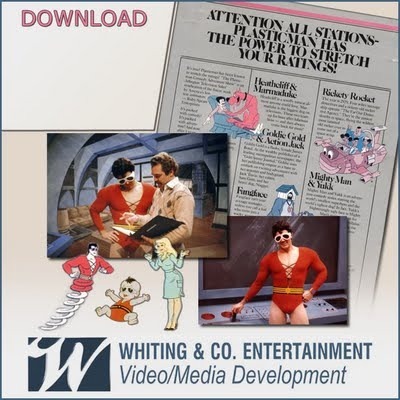 What does packaging for syndication typically entail? Shortening the running time?
What does packaging for syndication typically entail? Shortening the running time?
Re-packaging for syndication usually entails changing the format and structure of the show. They wanted to go from once a week to five days a week. That meant they need 130 half-hour shows, which is five days a week for six months, and then it starts again. A re-packaged show is actually a new entity separate from the original, but containing some of the same content. We edited some of the cartoons and segments to fit time frames.
Did you ever have to ask for new animated material?
Not really. We just edited animated material that already existed into our show format. That's how our live Plastic Man has conversations with the animated Chief. We used inter-cuts and editing of phrases the Chief spoke to Plastic Man in the cartoons to have her speak to our live-action Plastic Man.
What was the process like to get approval from DC Comics?
I have no clue. Ruby-Spears handled all of that. I was never asked by DC Comics to change anything.
How did the budget work—did Ruby-Spears pay for the live action segments? If so, how did you convince them to take that risk? If they did not pay for the segments, who did and how did you convince them?
Arlington Television paid for the production of the live action segments as part of their partnership/licensing deal with Ruby-Spears. As such, the newly packaged and assembled shows (with live host) became new product which belonged to Arlington (Simmons), as long as they remained intact. Some years later, Simmons assigned the rights to me.
Did you hand-pick Mark Taylor or did you have an audition process? If auditions, how many showed up? Any funny stories?
I didn't have time to set up a full casting call to find my "Plas" on short notice, so I hired [a] company to help with the talent search. Soon thereafter, [someone from the company] saw Taylor Marks [his stage name] doing stand-up comedy in San Francisco one night and called me the next day to say, "I've got the guy. He's perfect. He's even looks like Plastic Man." I auditioned Mark and said, "Look no further. That's him."
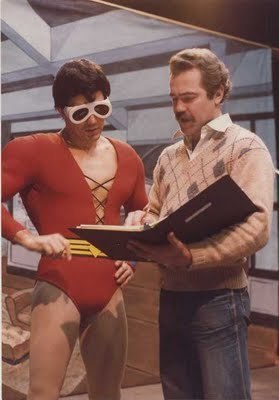 Mark Taylor and Steve Whiting
Mark Taylor and Steve Whiting
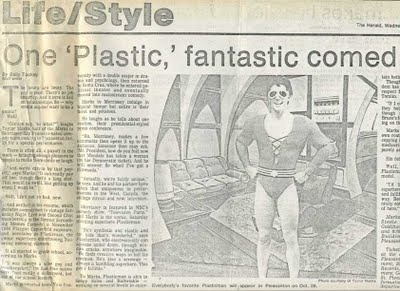
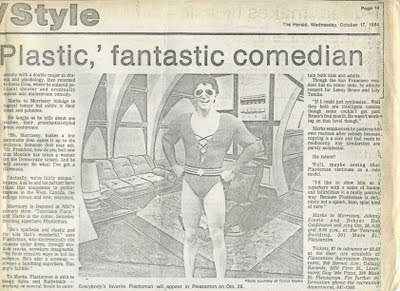 This newspaper article was too big for one scan.
This newspaper article was too big for one scan.
How much of the segments were scripted versus ad-libbed?
Simmons gave me two writers, [both of] whom I'd worked with on previous shows. One was Steve Arwood, who wrote for Riders in the Sky out of Nashville, and the other was Rick Sanchec. Jeff gave Rick just enough of an advance check to come to California, but no money to get home until the shows were all written. He lived in the music room at my house and wrote day and night. We had the synopses of all the cartoons in written form, but we'd not seen all of the cartoons themselves. They also weren't available for us to view. No home VCRs in those days.
Anyway, we wrote specific introductions and gags to most of the cartoons and then generic intros and gags that could be used as filler. For 130 half-hour shows, it was a lot material.
Then on the set, when we were taping the intros, outros, segues, and random bits, Mark and I would first look at each script and if it felt like it worked, we'd go with it. If it didn't we'd use it as a springboard to ad-lib. A lot of the ad-lib stuff is among some of the best. We taped intros, wraparounds, and closes for about 3-4 weeks.
Meaning that you produced all the segments in 3-4 weeks? After that, no more Plastic Man shooting for the show?
It could have been up to six weeks of shooting. After that we went into post-production to integrate all of our live stuff. Each show had to time out to precisely 28:30, with the black holes for commercials built into the masters. That took several months.
How long (in pages) was a script?
For the live segments, the script was only about two pages per show.
Who made the costume?
Oh, wow, a stage costume designer based in San Francisco.
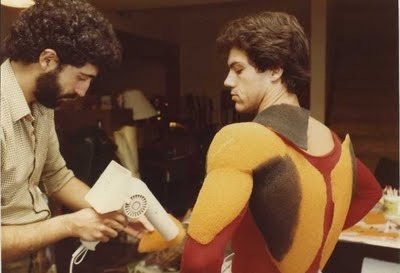 Were there ever characters besides PM in the segments? If not, did you want guest stars at any point?
Were there ever characters besides PM in the segments? If not, did you want guest stars at any point?
There was no time to develop those kinds of elements. [However], Plastic Man did refer and bring out his relatives, including Plastic Wrap, Plastic Foil, Plastic Container, and others.
Any funny stories about shoots that went wrong? Accidents? Embarrassments?
Many. We had a great comedian playing a superhero in a leotard [among] grizzled old pro tech guys on a closed set. Funny stories aplenty. I'd have to run back the memory tapes with Mark and some of the crew that are still with me to decide the best that are also mentionable ones.
Were all the segments filmed on one set? Did you ever travel to film a segment?
All were done on a single sound stage.
How long did it take to shoot a typical segment?
There were no typical segments. The straight forward introductions and segue throwaways went quite quickly, and we could do two or three of those in an hour. When we were shooting shots that we knew we were going to manipulate in post-production using what was at the time very advanced DVE (Digital Video Effects), it took a lot longer. Stuff we did on green screen at that time was very precise and difficult to make work at all convincingly. Some introductions with effects and rigging by our gaffers and effects guys would take two or three hours to set up. When, on camera, our Plastic Man transforms from a tire to himself and moves right into an introduction, for example, it took about two hours to set up. It still stands up today…so to speak. Some great stage and video edit technicians put their heads together to make that work impressively for its time.
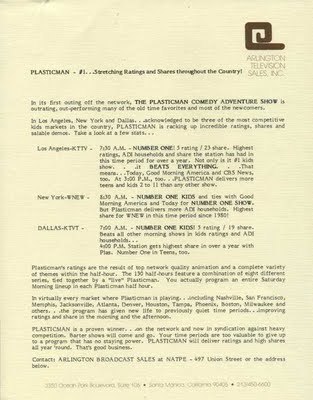 How did you get PM to join "security" for the Democratic National Convention?
How did you get PM to join "security" for the Democratic National Convention?
At the time, I was not an unknown producer/director in the market and I used my access to get Plastic Man the credentials he needed.
You said at one point that the segments had generated $4 million. Do you mean in ad revenue?
Our PMCAS was sold into syndication as a first-run off-network series. What I was quoted as saying in terms of revenues referred to the ADI market sales figures. What the ad revenue figures actually were could only come from the stations themselves. It's my understanding that the local stations [did] quite well with the series from their spot-ad revenues.
Have you done any other superhero projects since?
No, except for working with superstar athletes, musicians, and politician.
Have you ever been interviewed about PM for a comics-related publication?
I've done several interviews and been quoted with varying degrees of accuracy.
Do you still have any memorabilia related to the segments—scripts, promotional material, merchandise?
Yes, suppose I do. A portion of my personal tape archive vault is devoted to good old Plas. In a warehouse, I have some of the hand-painted set backdrops, props, T-shirts, fan photos, and who knows what all else.
What do you think about a live-action PM movie? Or should it be entirely CGI?
I feel the wife in The Incredibles was a total rip-off of Plastic Man. I think Plastic Man could be a tremendous live character concept outside of animation. I know exactly how it could and should be done…but I'm not telling.
Next: Mark Taylor (Plastic Man—live action).
Introduction to subseries "The Plastic Man Comedy Adventure Show" (including list of interviewees).
How did you get the job of packaging Plastic Man for syndication? Don't the big companies like Ruby-Spears typically do that themselves?
Arlington Television was a divisional offshoot of Golden West Television which at the time was owned by Jeff Simmons. I had produced and directed many TV shows for Jeff in the five years prior to Plastic Man. When Arlington made the deal with Ruby-Spears to repackage Plastic Man, Jeff Simmons told them he had just the guy to create the shows.
I got a call from Simmons in which he said, cryptically, "Son, Plastic Man looms large in your future" and I said "Who?" I had about three days before my interview with Ruby-Spears to create a show using wraparounds to introduce the library of cartoons. I figured who better to introduce the cartoons than Plastic Man himself. I'd been a fan of Captain Satellite, a character who hosted cartoon shows on a local San Francisco Bay Area station when I was a kid. I think I finalized the idea for the pitch on the plane to LA and I'm sure I heard some of the ideas for the first time as they came out of my mouth during the meeting.
[At the offices of] Joe Ruby and Ken Spears, I pitched them my idea of a live Plastic Man hosting the show from the Plasti-Jet and talking directly to the young viewers as friends. They bought the creative concept on the spot. I got the gig with full control to produce it in the San Francisco Bay Area.
 What does packaging for syndication typically entail? Shortening the running time?
What does packaging for syndication typically entail? Shortening the running time? Re-packaging for syndication usually entails changing the format and structure of the show. They wanted to go from once a week to five days a week. That meant they need 130 half-hour shows, which is five days a week for six months, and then it starts again. A re-packaged show is actually a new entity separate from the original, but containing some of the same content. We edited some of the cartoons and segments to fit time frames.
Did you ever have to ask for new animated material?
Not really. We just edited animated material that already existed into our show format. That's how our live Plastic Man has conversations with the animated Chief. We used inter-cuts and editing of phrases the Chief spoke to Plastic Man in the cartoons to have her speak to our live-action Plastic Man.
What was the process like to get approval from DC Comics?
I have no clue. Ruby-Spears handled all of that. I was never asked by DC Comics to change anything.
How did the budget work—did Ruby-Spears pay for the live action segments? If so, how did you convince them to take that risk? If they did not pay for the segments, who did and how did you convince them?
Arlington Television paid for the production of the live action segments as part of their partnership/licensing deal with Ruby-Spears. As such, the newly packaged and assembled shows (with live host) became new product which belonged to Arlington (Simmons), as long as they remained intact. Some years later, Simmons assigned the rights to me.
Did you hand-pick Mark Taylor or did you have an audition process? If auditions, how many showed up? Any funny stories?
I didn't have time to set up a full casting call to find my "Plas" on short notice, so I hired [a] company to help with the talent search. Soon thereafter, [someone from the company] saw Taylor Marks [his stage name] doing stand-up comedy in San Francisco one night and called me the next day to say, "I've got the guy. He's perfect. He's even looks like Plastic Man." I auditioned Mark and said, "Look no further. That's him."
 Mark Taylor and Steve Whiting
Mark Taylor and Steve Whiting
 This newspaper article was too big for one scan.
This newspaper article was too big for one scan.How much of the segments were scripted versus ad-libbed?
Simmons gave me two writers, [both of] whom I'd worked with on previous shows. One was Steve Arwood, who wrote for Riders in the Sky out of Nashville, and the other was Rick Sanchec. Jeff gave Rick just enough of an advance check to come to California, but no money to get home until the shows were all written. He lived in the music room at my house and wrote day and night. We had the synopses of all the cartoons in written form, but we'd not seen all of the cartoons themselves. They also weren't available for us to view. No home VCRs in those days.
Anyway, we wrote specific introductions and gags to most of the cartoons and then generic intros and gags that could be used as filler. For 130 half-hour shows, it was a lot material.
Then on the set, when we were taping the intros, outros, segues, and random bits, Mark and I would first look at each script and if it felt like it worked, we'd go with it. If it didn't we'd use it as a springboard to ad-lib. A lot of the ad-lib stuff is among some of the best. We taped intros, wraparounds, and closes for about 3-4 weeks.
Meaning that you produced all the segments in 3-4 weeks? After that, no more Plastic Man shooting for the show?
It could have been up to six weeks of shooting. After that we went into post-production to integrate all of our live stuff. Each show had to time out to precisely 28:30, with the black holes for commercials built into the masters. That took several months.
How long (in pages) was a script?
For the live segments, the script was only about two pages per show.
Who made the costume?
Oh, wow, a stage costume designer based in San Francisco.
 Were there ever characters besides PM in the segments? If not, did you want guest stars at any point?
Were there ever characters besides PM in the segments? If not, did you want guest stars at any point?There was no time to develop those kinds of elements. [However], Plastic Man did refer and bring out his relatives, including Plastic Wrap, Plastic Foil, Plastic Container, and others.
Any funny stories about shoots that went wrong? Accidents? Embarrassments?
Many. We had a great comedian playing a superhero in a leotard [among] grizzled old pro tech guys on a closed set. Funny stories aplenty. I'd have to run back the memory tapes with Mark and some of the crew that are still with me to decide the best that are also mentionable ones.
Were all the segments filmed on one set? Did you ever travel to film a segment?
All were done on a single sound stage.
How long did it take to shoot a typical segment?
There were no typical segments. The straight forward introductions and segue throwaways went quite quickly, and we could do two or three of those in an hour. When we were shooting shots that we knew we were going to manipulate in post-production using what was at the time very advanced DVE (Digital Video Effects), it took a lot longer. Stuff we did on green screen at that time was very precise and difficult to make work at all convincingly. Some introductions with effects and rigging by our gaffers and effects guys would take two or three hours to set up. When, on camera, our Plastic Man transforms from a tire to himself and moves right into an introduction, for example, it took about two hours to set up. It still stands up today…so to speak. Some great stage and video edit technicians put their heads together to make that work impressively for its time.
 How did you get PM to join "security" for the Democratic National Convention?
How did you get PM to join "security" for the Democratic National Convention?At the time, I was not an unknown producer/director in the market and I used my access to get Plastic Man the credentials he needed.
You said at one point that the segments had generated $4 million. Do you mean in ad revenue?
Our PMCAS was sold into syndication as a first-run off-network series. What I was quoted as saying in terms of revenues referred to the ADI market sales figures. What the ad revenue figures actually were could only come from the stations themselves. It's my understanding that the local stations [did] quite well with the series from their spot-ad revenues.
Have you done any other superhero projects since?
No, except for working with superstar athletes, musicians, and politician.
Have you ever been interviewed about PM for a comics-related publication?
I've done several interviews and been quoted with varying degrees of accuracy.
Do you still have any memorabilia related to the segments—scripts, promotional material, merchandise?
Yes, suppose I do. A portion of my personal tape archive vault is devoted to good old Plas. In a warehouse, I have some of the hand-painted set backdrops, props, T-shirts, fan photos, and who knows what all else.
What do you think about a live-action PM movie? Or should it be entirely CGI?
I feel the wife in The Incredibles was a total rip-off of Plastic Man. I think Plastic Man could be a tremendous live character concept outside of animation. I know exactly how it could and should be done…but I'm not telling.
Next: Mark Taylor (Plastic Man—live action).
Published on September 30, 2011 04:43
Super '70s and '80s: "The Plastic Man Comedy Show"—Steve Whiting, producer/director
Introduction to series "Super '70s and '80s."
Introduction to subseries "The Plastic Man Comedy Show" (including list of interviewees).
How did you get the job of packaging Plastic Man for syndication? Don't the big companies like Ruby-Spears typically do that themselves?
Arlington Television was a divisional offshoot of Golden West Television which at the time was owned by Jeff Simmons. I had produced and directed many TV shows for Jeff in the five years prior to Plastic Man. When Arlington made the deal with Ruby-Spears to repackage Plastic Man, Jeff Simmons told them he had just the guy to create the shows.
I got a call from Simmons in which he said, cryptically, "Son, Plastic Man looms large in your future" and I said "Who?" I had about three days before my interview with Ruby-Spears to create a show using wraparounds to introduce the library of cartoons. I figured who better to introduce the cartoons than Plastic Man himself. I'd been a fan of Captain Satellite, a character who hosted cartoon shows on a local San Francisco Bay Area station when I was a kid. I think I finalized the idea for the pitch on the plane to LA and I'm sure I heard some of the ideas for the first time as they came out of my mouth during the meeting.
[At the offices of] Joe Ruby and Ken Spears, I pitched them my idea of a live Plastic Man hosting the show from the Plasti-Jet and talking directly to the young viewers as friends. They bought the creative concept on the spot. I got the gig with full control to produce it in the San Francisco Bay Area.
 What does packaging for syndication typically entail? Shortening the running time?
What does packaging for syndication typically entail? Shortening the running time?
Re-packaging for syndication usually entails changing the format and structure of the show. They wanted to go from once a week to five days a week. That meant they need 130 half-hour shows, which is five days a week for six months, and then it starts again. A re-packaged show is actually a new entity separate from the original, but containing some of the same content. We edited some of the cartoons and segments to fit time frames.
Did you ever have to ask for new animated material?
Not really. We just edited animated material that already existed into our show format. That's how our live Plastic Man has conversations with the animated Chief. We used inter-cuts and editing of phrases the Chief spoke to Plastic Man in the cartoons to have her speak to our live-action Plastic Man.
What was the process like to get approval from DC Comics?
I have no clue. Ruby-Spears handled all of that. I was never asked by DC Comics to change anything.
How did the budget work—did Ruby-Spears pay for the live action segments? If so, how did you convince them to take that risk? If they did not pay for the segments, who did and how did you convince them?
Arlington Television paid for the production of the live action segments as part of their partnership/licensing deal with Ruby-Spears. As such, the newly packaged and assembled shows (with live host) became new product which belonged to Arlington (Simmons), as long as they remained intact. Some years later, Simmons assigned the rights to me.
Did you hand-pick Mark Taylor or did you have an audition process? If auditions, how many showed up? Any funny stories?
I didn't have time to set up a full casting call to find my "Plas" on short notice, so I hired [a] company to help with the talent search. Soon thereafter, [someone from the company] saw Taylor Marks [his stage name] doing stand-up comedy in San Francisco one night and called me the next day to say, "I've got the guy. He's perfect. He's even looks like Plastic Man." I auditioned Mark and said, "Look no further. That's him."
 Mark Taylor and Steve Whiting
Mark Taylor and Steve Whiting

 This newspaper article was too big for one scan.
This newspaper article was too big for one scan.
How much of the segments were scripted versus ad-libbed?
Simmons gave me two writers, [both of] whom I'd worked with on previous shows. One was Steve Arwood, who wrote for Riders in the Sky out of Nashville, and the other was Rick Sanchec. Jeff gave Rick just enough of an advance check to come to California, but no money to get home until the shows were all written. He lived in the music room at my house and wrote day and night. We had the synopses of all the cartoons in written form, but we'd not seen all of the cartoons themselves. They also weren't available for us to view. No home VCRs in those days.
Anyway, we wrote specific introductions and gags to most of the cartoons and then generic intros and gags that could be used as filler. For 130 half-hour shows, it was a lot material.
Then on the set, when we were taping the intros, outros, segues, and random bits, Mark and I would first look at each script and if it felt like it worked, we'd go with it. If it didn't we'd use it as a springboard to ad-lib. A lot of the ad-lib stuff is among some of the best. We taped intros, wraparounds, and closes for about 3-4 weeks.
Meaning that you produced all the segments in 3-4 weeks? After that, no more Plastic Man shooting for the show?
It could have been up to six weeks of shooting. After that we went into post-production to integrate all of our live stuff. Each show had to time out to precisely 28:30, with the black holes for commercials built into the masters. That took several months.
How long (in pages) was a script?
For the live segments, the script was only about two pages per show.
Who made the costume?
Oh, wow, a stage costume designer based in San Francisco.
 Were there ever characters besides PM in the segments? If not, did you want guest stars at any point?
Were there ever characters besides PM in the segments? If not, did you want guest stars at any point?
There was no time to develop those kinds of elements. [However], Plastic Man did refer and bring out his relatives, including Plastic Wrap, Plastic Foil, Plastic Container, and others.
Any funny stories about shoots that went wrong? Accidents? Embarrassments?
Many. We had a great comedian playing a superhero in a leotard [among] grizzled old pro tech guys on a closed set. Funny stories aplenty. I'd have to run back the memory tapes with Mark and some of the crew that are still with me to decide the best that are also mentionable ones.
Were all the segments filmed on one set? Did you ever travel to film a segment?
All were done on a single sound stage.
How long did it take to shoot a typical segment?
There were no typical segments. The straight forward introductions and segue throwaways went quite quickly, and we could do two or three of those in an hour. When we were shooting shots that we knew we were going to manipulate in post-production using what was at the time very advanced DVE (Digital Video Effects), it took a lot longer. Stuff we did on green screen at that time was very precise and difficult to make work at all convincingly. Some introductions with effects and rigging by our gaffers and effects guys would take two or three hours to set up. When, on camera, our Plastic Man transforms from a tire to himself and moves right into an introduction, for example, it took about two hours to set up. It still stands up today…so to speak. Some great stage and video edit technicians put their heads together to make that work impressively for its time.
 How did you get PM to join "security" for the Democratic National Convention?
How did you get PM to join "security" for the Democratic National Convention?
At the time, I was not an unknown producer/director in the market and I used my access to get Plastic Man the credentials he needed.
You said at one point that the segments had generated $4 million. Do you mean in ad revenue?
Our PMCAS was sold into syndication as a first-run off-network series. What I was quoted as saying in terms of revenues referred to the ADI market sales figures. What the ad revenue figures actually were could only come from the stations themselves. It's my understanding that the local stations [did] quite well with the series from their spot-ad revenues.
Have you done any other superhero projects since?
No, except for working with superstar athletes, musicians, and politician.
Have you ever been interviewed about PM for a comics-related publication?
I've done several interviews and been quoted with varying degrees of accuracy.
Do you still have any memorabilia related to the segments—scripts, promotional material, merchandise?
Yes, suppose I do. A portion of my personal tape archive vault is devoted to good old Plas. In a warehouse, I have some of the hand-painted set backdrops, props, T-shirts, fan photos, and who knows what all else.
What do you think about a live-action PM movie? Or should it be entirely CGI?
I feel the wife in The Incredibles was a total rip-off of Plastic Man. I think Plastic Man could be a tremendous live character concept outside of animation. I know exactly how it could and should be done…but I'm not telling.
Next: Mark Taylor (Plastic Man—live action).
Introduction to subseries "The Plastic Man Comedy Show" (including list of interviewees).
How did you get the job of packaging Plastic Man for syndication? Don't the big companies like Ruby-Spears typically do that themselves?
Arlington Television was a divisional offshoot of Golden West Television which at the time was owned by Jeff Simmons. I had produced and directed many TV shows for Jeff in the five years prior to Plastic Man. When Arlington made the deal with Ruby-Spears to repackage Plastic Man, Jeff Simmons told them he had just the guy to create the shows.
I got a call from Simmons in which he said, cryptically, "Son, Plastic Man looms large in your future" and I said "Who?" I had about three days before my interview with Ruby-Spears to create a show using wraparounds to introduce the library of cartoons. I figured who better to introduce the cartoons than Plastic Man himself. I'd been a fan of Captain Satellite, a character who hosted cartoon shows on a local San Francisco Bay Area station when I was a kid. I think I finalized the idea for the pitch on the plane to LA and I'm sure I heard some of the ideas for the first time as they came out of my mouth during the meeting.
[At the offices of] Joe Ruby and Ken Spears, I pitched them my idea of a live Plastic Man hosting the show from the Plasti-Jet and talking directly to the young viewers as friends. They bought the creative concept on the spot. I got the gig with full control to produce it in the San Francisco Bay Area.
 What does packaging for syndication typically entail? Shortening the running time?
What does packaging for syndication typically entail? Shortening the running time? Re-packaging for syndication usually entails changing the format and structure of the show. They wanted to go from once a week to five days a week. That meant they need 130 half-hour shows, which is five days a week for six months, and then it starts again. A re-packaged show is actually a new entity separate from the original, but containing some of the same content. We edited some of the cartoons and segments to fit time frames.
Did you ever have to ask for new animated material?
Not really. We just edited animated material that already existed into our show format. That's how our live Plastic Man has conversations with the animated Chief. We used inter-cuts and editing of phrases the Chief spoke to Plastic Man in the cartoons to have her speak to our live-action Plastic Man.
What was the process like to get approval from DC Comics?
I have no clue. Ruby-Spears handled all of that. I was never asked by DC Comics to change anything.
How did the budget work—did Ruby-Spears pay for the live action segments? If so, how did you convince them to take that risk? If they did not pay for the segments, who did and how did you convince them?
Arlington Television paid for the production of the live action segments as part of their partnership/licensing deal with Ruby-Spears. As such, the newly packaged and assembled shows (with live host) became new product which belonged to Arlington (Simmons), as long as they remained intact. Some years later, Simmons assigned the rights to me.
Did you hand-pick Mark Taylor or did you have an audition process? If auditions, how many showed up? Any funny stories?
I didn't have time to set up a full casting call to find my "Plas" on short notice, so I hired [a] company to help with the talent search. Soon thereafter, [someone from the company] saw Taylor Marks [his stage name] doing stand-up comedy in San Francisco one night and called me the next day to say, "I've got the guy. He's perfect. He's even looks like Plastic Man." I auditioned Mark and said, "Look no further. That's him."
 Mark Taylor and Steve Whiting
Mark Taylor and Steve Whiting
 This newspaper article was too big for one scan.
This newspaper article was too big for one scan.How much of the segments were scripted versus ad-libbed?
Simmons gave me two writers, [both of] whom I'd worked with on previous shows. One was Steve Arwood, who wrote for Riders in the Sky out of Nashville, and the other was Rick Sanchec. Jeff gave Rick just enough of an advance check to come to California, but no money to get home until the shows were all written. He lived in the music room at my house and wrote day and night. We had the synopses of all the cartoons in written form, but we'd not seen all of the cartoons themselves. They also weren't available for us to view. No home VCRs in those days.
Anyway, we wrote specific introductions and gags to most of the cartoons and then generic intros and gags that could be used as filler. For 130 half-hour shows, it was a lot material.
Then on the set, when we were taping the intros, outros, segues, and random bits, Mark and I would first look at each script and if it felt like it worked, we'd go with it. If it didn't we'd use it as a springboard to ad-lib. A lot of the ad-lib stuff is among some of the best. We taped intros, wraparounds, and closes for about 3-4 weeks.
Meaning that you produced all the segments in 3-4 weeks? After that, no more Plastic Man shooting for the show?
It could have been up to six weeks of shooting. After that we went into post-production to integrate all of our live stuff. Each show had to time out to precisely 28:30, with the black holes for commercials built into the masters. That took several months.
How long (in pages) was a script?
For the live segments, the script was only about two pages per show.
Who made the costume?
Oh, wow, a stage costume designer based in San Francisco.
 Were there ever characters besides PM in the segments? If not, did you want guest stars at any point?
Were there ever characters besides PM in the segments? If not, did you want guest stars at any point?There was no time to develop those kinds of elements. [However], Plastic Man did refer and bring out his relatives, including Plastic Wrap, Plastic Foil, Plastic Container, and others.
Any funny stories about shoots that went wrong? Accidents? Embarrassments?
Many. We had a great comedian playing a superhero in a leotard [among] grizzled old pro tech guys on a closed set. Funny stories aplenty. I'd have to run back the memory tapes with Mark and some of the crew that are still with me to decide the best that are also mentionable ones.
Were all the segments filmed on one set? Did you ever travel to film a segment?
All were done on a single sound stage.
How long did it take to shoot a typical segment?
There were no typical segments. The straight forward introductions and segue throwaways went quite quickly, and we could do two or three of those in an hour. When we were shooting shots that we knew we were going to manipulate in post-production using what was at the time very advanced DVE (Digital Video Effects), it took a lot longer. Stuff we did on green screen at that time was very precise and difficult to make work at all convincingly. Some introductions with effects and rigging by our gaffers and effects guys would take two or three hours to set up. When, on camera, our Plastic Man transforms from a tire to himself and moves right into an introduction, for example, it took about two hours to set up. It still stands up today…so to speak. Some great stage and video edit technicians put their heads together to make that work impressively for its time.
 How did you get PM to join "security" for the Democratic National Convention?
How did you get PM to join "security" for the Democratic National Convention?At the time, I was not an unknown producer/director in the market and I used my access to get Plastic Man the credentials he needed.
You said at one point that the segments had generated $4 million. Do you mean in ad revenue?
Our PMCAS was sold into syndication as a first-run off-network series. What I was quoted as saying in terms of revenues referred to the ADI market sales figures. What the ad revenue figures actually were could only come from the stations themselves. It's my understanding that the local stations [did] quite well with the series from their spot-ad revenues.
Have you done any other superhero projects since?
No, except for working with superstar athletes, musicians, and politician.
Have you ever been interviewed about PM for a comics-related publication?
I've done several interviews and been quoted with varying degrees of accuracy.
Do you still have any memorabilia related to the segments—scripts, promotional material, merchandise?
Yes, suppose I do. A portion of my personal tape archive vault is devoted to good old Plas. In a warehouse, I have some of the hand-painted set backdrops, props, T-shirts, fan photos, and who knows what all else.
What do you think about a live-action PM movie? Or should it be entirely CGI?
I feel the wife in The Incredibles was a total rip-off of Plastic Man. I think Plastic Man could be a tremendous live character concept outside of animation. I know exactly how it could and should be done…but I'm not telling.
Next: Mark Taylor (Plastic Man—live action).
Published on September 30, 2011 04:43
September 29, 2011
Super '70s and '80s: "The Plastic Man Comedy Adventure Show"—introduction
Introduction to series "Super '70s and '80s."
Back Issue #3 (4/04) included a photo of the first (and still only) live-action Plastic Man, who hosted the syndicated version of the Plastic Man cartoon of the early 1980s.
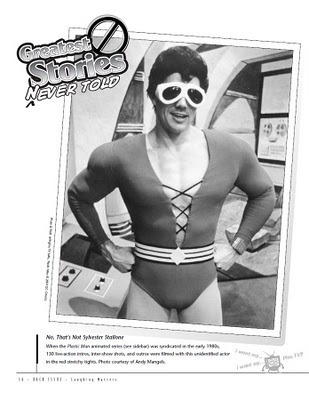
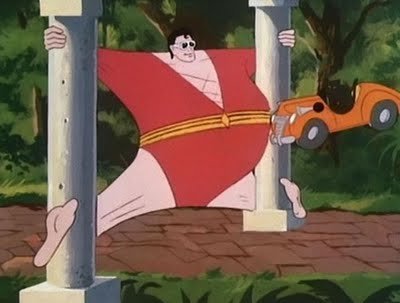 That caption called him an "unidentified actor." I wanted to get rid of that "un."
That caption called him an "unidentified actor." I wanted to get rid of that "un."
A simple search revealed that he was Mark Taylor, but that did not automatically make the task easier. There are approximately 700,000 people in America named Mark Taylor (and by "approximately" I mean "random guess").
Faced with such a generic name, I have found that the best option in minimizing the search time is this: forgo looking directly for the person in question and rather find someone (with a less generic name) who knew the missing person. That is not always easy either, but in this case, it worked as desired. Easily found online, the producer of the live-action Plastic Man segments was a Steve Whiting—not only is "Whiting" a less common surname than "Taylor," but it turned out that Steve had a site...and was still in touch with Mark.
Mark turned out to be a gem well worth the hunt. He bravely shared one of the most touching and inspiring stories to come out of this entire series. It was apropos that Mark demonstrated how much some people need to stretch to save a life—including their own.
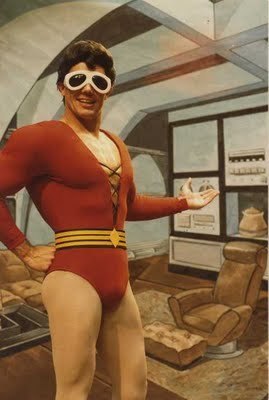
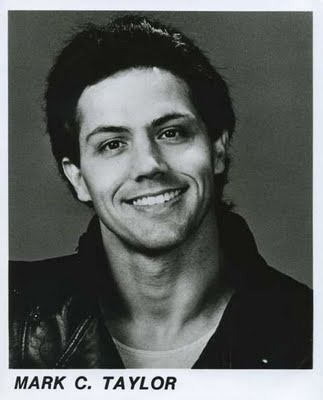
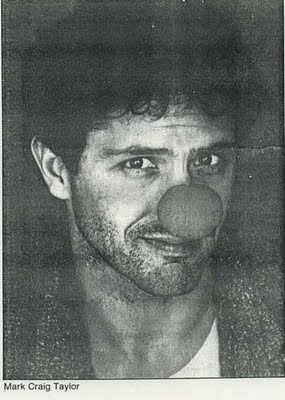 Images courtesy of Mark Taylor and Steve Whiting.
Images courtesy of Mark Taylor and Steve Whiting.
I got permission to post all images; if you want to repost, please do the same and ask me first.
Interviewed (2 parts):
Steve Whiting, producer/director
Mark Taylor (Plastic Man—live action)
Back Issue #3 (4/04) included a photo of the first (and still only) live-action Plastic Man, who hosted the syndicated version of the Plastic Man cartoon of the early 1980s.

 That caption called him an "unidentified actor." I wanted to get rid of that "un."
That caption called him an "unidentified actor." I wanted to get rid of that "un."A simple search revealed that he was Mark Taylor, but that did not automatically make the task easier. There are approximately 700,000 people in America named Mark Taylor (and by "approximately" I mean "random guess").
Faced with such a generic name, I have found that the best option in minimizing the search time is this: forgo looking directly for the person in question and rather find someone (with a less generic name) who knew the missing person. That is not always easy either, but in this case, it worked as desired. Easily found online, the producer of the live-action Plastic Man segments was a Steve Whiting—not only is "Whiting" a less common surname than "Taylor," but it turned out that Steve had a site...and was still in touch with Mark.
Mark turned out to be a gem well worth the hunt. He bravely shared one of the most touching and inspiring stories to come out of this entire series. It was apropos that Mark demonstrated how much some people need to stretch to save a life—including their own.


 Images courtesy of Mark Taylor and Steve Whiting.
Images courtesy of Mark Taylor and Steve Whiting.I got permission to post all images; if you want to repost, please do the same and ask me first.
Interviewed (2 parts):
Steve Whiting, producer/director
Mark Taylor (Plastic Man—live action)
Published on September 29, 2011 04:32
Super '70s and '80s: "The Plastic Man Comedy Show"—introduction
Introduction to series "Super '70s and '80s."
Back Issue #3 (4/04) included a photo of the first (and still only) live-action Plastic Man, who hosted the syndicated version of the Plastic Man cartoon of the early 1980s.
 The caption called him an "unidentified actor," firing me up to find him.
The caption called him an "unidentified actor," firing me up to find him.
He was actually never a mystery. His name is Mark Taylor and he bravely shared one of the most touching and inspiring stories to come out of this entire series. Appropriately, Mark demonstrates how much some people need to stretch to save a life—including their own.


 Images courtesy of Mark and Steve Whiting.
Images courtesy of Mark and Steve Whiting.
I got permission to post all images; if you want to repost, please do the same and ask me first.
Interviewed (2 parts):
Steve Whiting, producer/director
Mark Taylor (Plastic Man—live action)
Back Issue #3 (4/04) included a photo of the first (and still only) live-action Plastic Man, who hosted the syndicated version of the Plastic Man cartoon of the early 1980s.
 The caption called him an "unidentified actor," firing me up to find him.
The caption called him an "unidentified actor," firing me up to find him. He was actually never a mystery. His name is Mark Taylor and he bravely shared one of the most touching and inspiring stories to come out of this entire series. Appropriately, Mark demonstrates how much some people need to stretch to save a life—including their own.


 Images courtesy of Mark and Steve Whiting.
Images courtesy of Mark and Steve Whiting.I got permission to post all images; if you want to repost, please do the same and ask me first.
Interviewed (2 parts):
Steve Whiting, producer/director
Mark Taylor (Plastic Man—live action)
Published on September 29, 2011 04:32
September 28, 2011
Super '70s and '80s: "Bugs Bunny Meets the Superheroes"
Introduction to series "Super '70s and '80s."
In the late 1970s, Rodger Hess produced a series of stage shows featuring live-action superheroes. This was one.
I got permission to post all images; if you want to repost, please do the same and ask me first.
Welcome to the first-ever oral history of Bugs Bunny Meets the Superheroes.
Performers interviewed:
Steve Cochran
Cate Fowler
Christine Gradl Seitz
Peter Kosta
Uriel Menson
Frank Stancati
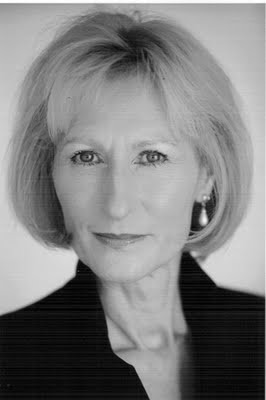 Cate Fowler now
Cate Fowler now
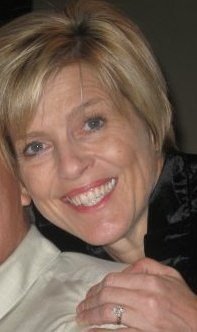 Christine Gradl Seitz now
Christine Gradl Seitz now
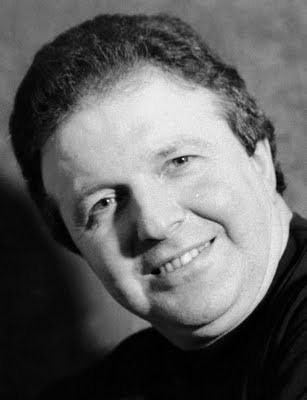 Peter Kosta now
Peter Kosta now
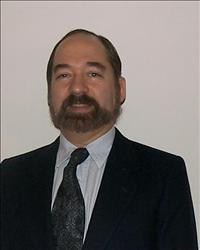 Uriel Menson now
Uriel Menson now
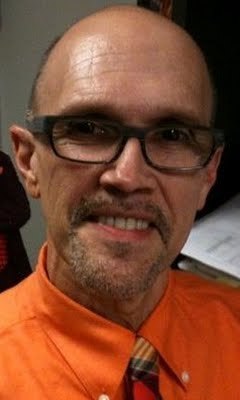 Frank Stancati now
Frank Stancati now
Notes I took during my initial contact with Cate Fowler:
there is a Cate Fowler with a website, but it's not herdespite others' speculation, it's also not her on this poster: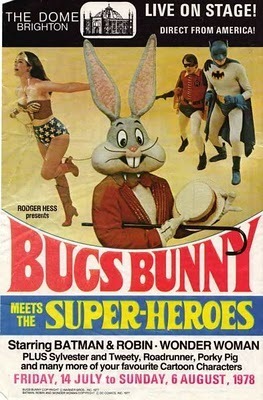
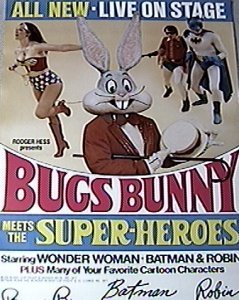 Initial reaction from Christine Gradl Seitz:
Initial reaction from Christine Gradl Seitz:
What a surprise. I had to look twice at the subject heading…I literally did a double take thinking, what the heck…someone must be kidding! I have the fondest memories of those days!
[NOTE: I did not interview them at the same time; I combined their answers since they were part of the same production.]
How did you get a job with Bugs Bunny Meets the Superheroes?
Christine Gradl Seitz: It was my first NY audition. I went to this audition because I heard I could get my Equity Card doing this gig.
Peter Kosta: I saw an advert in The Stage and auditioned and was offered the part.
Steve Cochran: I auditioned in the summer of 1979 following my graduation from the American Academy of Dramatic Arts. I graduated from the Academy hoping and imagining my first job would be something major, like Shakespeare, Arthur Miller, Tennessee Williams. I remember halfway through the audition I knew I had a role. I called my mother and told her how disappointed I was. She asked "Does it pay? Do you get in Actor's Equity? Do you travel?" [I said] "Yes to all of the above." [So] I took the job and played Wile E. Coyote and the Joker in Bugs Bunny Meets the Superheroes touring the U.S. The following year I was Doc (the narrator) in The Bugs Bunny Follies, touring the U.S. and Canada. Then the Company Manager of the Venezuela tour of The Bugs Bunny Follies and the United Kingdom tour of Bugs Bunny in Outer Space.
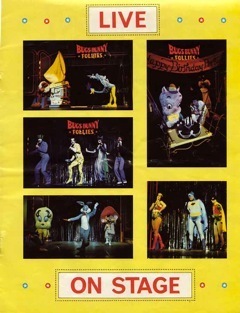 Courtesy of Steve Cochran.
Courtesy of Steve Cochran.
Uriel Menson: I saw an ad in Backstage for an additional audition, the first of which I couldn't get to. I hadn't planned on going to it, but on my way somewhere else, I had a little extra time, so I stopped in at Showcase Studios (I think that was the name of the rehearsal studio, it's long gone) and signed up to audition for Robin. I had loved to watch the show on TV when I was a kid. When I got the sides and read them over, I couldn't stop laughing at the lines I was about to say. Typical Robin lines like "Holy gee willikers." I pulled it together, went in to read, and stifling my desire to laugh out loud, I got through the lines. Guess I did a pretty good job since a few days later I got the call that I was hired.
What were you doing before BBMTS?
Cate Fowler: Working mainly in theatre and some TV.
Christine Gradl Seitz: I had just left college to move from Ohio to New York.
Frank Stancati: I had just gotten off a summer tour of Guys and Dolls.
Peter Kosta: I was in a West End play.
Steve Cochran: I performed in plays at Westwood High School in Westwood, New Jersey. Went to two years at the American Academy of Dramatic Arts and graduated in 1977. I worked, as practically every actor I knew did, as a waiter. I had a terrific waiter's job in the heart of the Broadway theater district.
Uriel Menson: I was Non-Equity going from audition to audition trying to get an acting job.
How old were you during the show?
Cate Fowler: In my early twenties.
Christine Gradl Seitz: I had just turned 19.
Frank Stancati: Hmm…27?
Peter Kosta: Twenties.
Uriel Menson: I was 26 when I started.
Which character(s) did you portray?
Cate Fowler: Wonder Woman.
Christine Gradl Seitz: Yosemite Sam and Catwoman (I think?).
Frank Stancati: The Penguin and Daffy Duck.
Peter Kosta: Sylvester the Cat and Robin.
Uriel Menson: Robin and Sylvester the Cat.
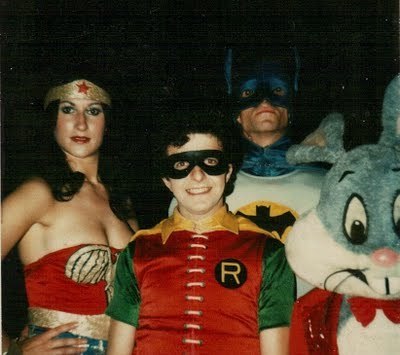 Cate Fowler as Wonder Woman, Peter Kosta as Robin; others unknown
Cate Fowler as Wonder Woman, Peter Kosta as Robin; others unknown
How much did you know about those character(s) before your role in BBMTS?
Cate Fowler: Not that much really, although I knew who they were, of course!
Christine Gradl Seitz: Well, I grew up with these cartoons so I suppose I was fairly familiar with the characters.
Frank Stancati: A lot. I used to watch the Batman TV program as well as read the comics. Used to watch Bugs cartoons as a kid.
Which other characters were in the show?
Christine Gradl Seitz: I remember Foghorn Leghorn, Batman and Robin, the Joker, and Speedy Gonzales.
Frank Stancati: Batman, Robin, Catwoman, Riddler, Porky Pig, Road Runner, Speedy [Gonzales], Tweety, Sylvester.
Peter Kosta: Bugs Bunny, Porky Pig, Yosemite Sam, Road Runner, Coyote Bill?, Wonder Woman, Tweety Bird, Joker, Penguin.
Uriel Menson: Other characters in the show were Batman, Riddler, Catwoman, Penguin, Commissioner Gordon, Bugs Bunny, Porky Pig, Wiley Coyote, Foghorn Leghorn, Yosemite Sam, Tweety Bird, and Speedy Gonzales. That's all I can remember right now.
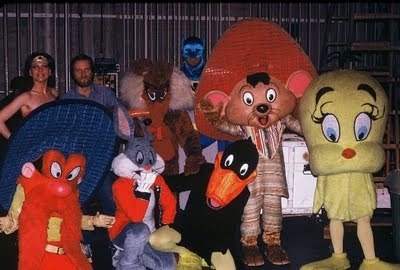 How much rehearsal did you do before the show opened?
How much rehearsal did you do before the show opened?
Christine Gradl Seitz: I think we rehearsed for two weeks in beautiful Lake George, NY.
Where did you perform with BBMTS?
Cate Fowler: London and a UK tour.
Christine Gradl Seitz: We toured small towns in the Midwest—beats me where? But I remember performing in large arenas or coliseums.
Frank Stancati: It was an eight-month tour all over the country.
Peter Kosta: Brighton and Wembley [in the UK].
Uriel Menson: The first year (1979-1980) we performed mostly in the Eastern U.S., all up and down. The second half of the second year (1980-1981) we performed primarily in the Western U.S.
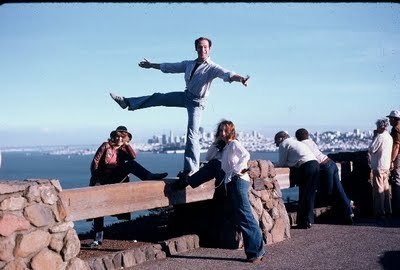
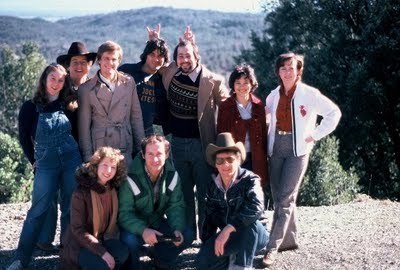
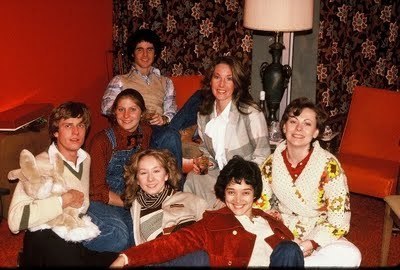
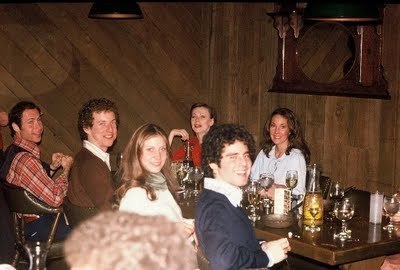 Photos courtesy of Uriel Menson.
Photos courtesy of Uriel Menson.
For how long did you perform with BBMTS?
Cate Fowler: Three summer engagements.
Christine Gradl Seitz: I stayed with the tour for six months.
Peter Kosta: A summer season.
Steve Cochran: Superheroes, one year. Follies, nine months. Space, three or four months.
Uriel Menson: I was on the road with the group for a tour-and-a-half, from 9/79 to 6/80, and then again from 1/81 to 6/81.
How did the show work—i.e. how many shows a day, how many days a week?
Christine Gradl Seitz: I remember doing two-show days on weekends and I remember traveling by van from city to city. But I couldn't tell you how many shows we did per week. I'm guessing sometimes six and sometimes eight?
Frank Stancati: Varied on our schedule. Sometimes up to three shows a day. Usually at least eight a week.
Steve Cochran: Often it was one show a day, sometimes twice a day, and at most three times a day. We did maybe ten shows a week. I do remember everyone being excited to play in Madison Square Garden's Felt Forum for ten days straight and having two or three shows a day with very limited time off. No one got to enjoy being home as we were so exhausted.
Uriel Menson: The schedule varied. It depended on how far we had to travel to each location and how many shows were booked. I think we played a maximum of three shows in any one day. We had days that were dedicated only to travel and an occasional day off. Sometimes we would arrive in a town in the afternoon after traveling all morning, set up, and do a show. Then sometimes we had to start to travel to the next town after finishing a show.
What was the show's storyline?
Cate Fowler: Superhero, space, and sports shows.
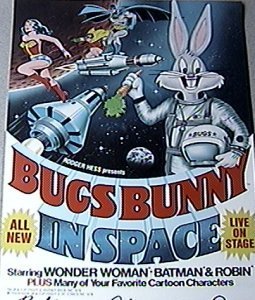
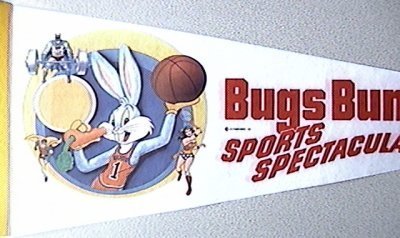 Christine Gradl Seitz: I have no idea. I'm not sure there really was one...was there?
Christine Gradl Seitz: I have no idea. I'm not sure there really was one...was there?
Frank Stancati: Porky's birthday and [villains show up] trying to spoil it!
Steve Cochran: It was a surprise party for Porky Pig, and the villains, Joker, Riddler, Catwoman and Penquin wanted to celebrate "The Good Old, Bad Old Days" (the song they sung) by ruining Porky's birthday. Batman and Robin save the day and Porky gets to have his party.
Was there music? If so, is there a list of the songs or even recordings of them anywhere?
Christine Gradl Seitz: One of [my songs] was "Anything You Can Do." I still remember some of the choreography. However, I pray there is no recording of this out there…?
Frank Stancati: The villains had a song called "Bad Old Days," which we sung live. Not aware of any recordings.
Peter Kosta: Yes, all on a click track. No commercial recordings that I know of.
Steve Cochran: It was a musical and the only numbers I recall were the opening which was the Looney Tunes theme song "This Is It" and the villains' first act number [already mentioned].
What was a typical audience reaction?
Cate Fowler: Very enthusiastic (and noisy!).
Christine Gradl Seitz: I remember the kids in the audience laughing. But then there was this showgirl number…I suppose that was thrown in to appeal to the parents. That was always odd to me—and it seemed the audience was also baffled by it.
Frank Stancati: Audiences loved it! Madison Square Garden was a hoot. All my family came and even they loved it. At times it felt like we were rock stars!
Steve Cochran: Joy when the kids saw each of the characters. At the curtain call, they would swarm the foot of the stage.
Any notable goofs or accidents that happened during a performance?
Cate Fowler: Only when the stage manager was overly generous with the flash powder!
Christine Gradl Seitz: I recall having trouble now and then getting off the floor with that big Yosemite Sam headpiece on. Foghorn Leghorn would usually help me up!
Frank Stancati: Of course! Injuries did occur. I do remember one funny episode when Porky fell on stage and couldn't get up. There was no "human" on stage at the time and most of the characters had no hands. They kind of rolled her into the wings.
Steve Cochran: Sure, lots. Wile E. Coyote's trap for the Road Runner didn't work once. My Coyote costume froze solid in Richmond, Virginia, when the temperature dropped below freezing one night. Jumped out of my Coyote feet. Had to roll Porky Pig off stage when she fell over and her costume wouldn't allow her to stand up.
Uriel Menson: Over the course of a year and a half, you can believe there were antics, goofs, and spills both onstage and off.
Did you meet with fans afterward while in costume? If so, did you sign autographs?
Cate Fowler: Yes, pretty well after every show. I must have signed thousands of autographs.
Frank Stancati: No, the villains were never asked to do that. Sometimes we'd do local TV shows as ourselves.
Peter Kosta: No, but signed autographs at the stage door as ourselves.
Steve Cochran: We went to a school for the deaf and blind in Pittsburgh and were blown away as the children touched us to identify who we were. Occasionally, I did appearances as the Joker in Kings Dominion amusement park in Virginia and in a TV commercial in Buffalo with stunt car drivers.
Uriel Menson: It was a very rare occurrence when we would go out after a show to meet the audience, with the exception of one of our actors who played Batman. He enjoyed going out to meet the kids after a show, whether we were supposed to or not. I don't remember any specific rules about it one way or the other. Most of us just wanted to get out of our hot costumes and get out of the venue. Those of us who could sign autographs on those few occasions where we did meet people, signed. Some characters had no hands to do it.
Did the show lead to other work for you?
Cate Fowler: Have continued working in the business, mainly TV and film, but never again as a superhero!
Do you still have a copy of the script?
Christine Gradl Seitz: You know, I think I do! I'd have to dig around but a few years ago I think I came across it...somewhere in some box...
Peter Kosta: No, all scripts were handed back.
What are you doing these days (professionally and personally)?
Cate Fowler: Working as an actress and presenter in London.
Christine Gradl Seitz: I am the artistic and executive director for a semi-professional theatre in Duluth, Minnesota. While we are known as a community-based theatre, we pay actors a small honorarium, but not weekly salaries, though we hire Equity actors now and then. We pay all staff and creative positions. So we consider ourselves as a semi-professional theatre.
Frank Stancati: After 30 years in the business as an actor and having a great career, I decided I needed a change. I am now a business representative for Actors' Equity Association.
Peter Kosta: I am directing and producing as well as doing the odd acting role. I have helped start up an "Off-Off-Broadway"-style theater.
Steve Cochran: I work as Associate Marketing Director for TheatreworksUSA, a company producing theatre for young audiences across the United States and Canada.
Uriel Menson: I am going to as many auditions as I can for my next project, whatever that might be, and doing all sorts of odd jobs to keep the money coming in.
What was your reaction when you heard why I was contacting you?
Cate Fowler: Surprise.
If you have children and/or grandchildren, what do they think about your time as a superhero?
Cate Fowler: No kids.
Has anyone else ever interviewed you about your time with BBMTS?
Cate Fowler: No, although I did a lot of TV and radio interviews at the time.
Christine Gradl Seitz: No. And it is so fun to think back to those days—thanks for sparking my memories.
Frank Stancati: I have never been interviewed before.
Are you still in touch with anyone you performed with on BBMTS?
Christine Gradl Seitz: Not anymore. Living in Duluth has taken me far from those that I used to bump into on the streets of New York.
Peter Kosta: Yes, Genevieve (Genie) Davies, who played Porky Pig.
Steve Cochran: In the past year, I've touched base with a few of them. Some have passed away and still others I have no idea what happened to them.
Uriel Menson: On occasion I still see Steve Cochran and very rarely Rodger Hess and Genevieve Davis. W.W. Smith, who played one of our Batmen, is gone now.
Do you by chance have contact info (or ANY info) for other superhero/villain performers from the show? Names I've been told: Bonnie Young, Joni Massella, Joe Duquesne, Doug Boyes, Bill Covington, Joe Douquette, Robert Kellett, Charmian Clark, Jimmy May, Robert Weber, Lori Lynott...?
Cate Fowler: I have contacted Phil Compton who played Batman one year, and am waiting to hear back.
What is your fondest memory of the show?
Cate Fowler: The enduring friendships I made. So many of us are still in touch. I have visited the U.S. and only [in 2009] met up again in London with our two American dance captains.
Christine Gradl Seitz: Rehearsals. Lake George was like a vacation before the job. I have fond memories of traveling at times, however the van took its toll and sometimes we were crabby with each other. But all in all, we had a good group.
Frank Stancati: I had a great time on the tour. Of course, at times there were things to complain about. Sometimes the travel was long, but on the whole the cast was fun. We all got along for the most part and made lots of kids happy.
Steve Cochran: The sound of the kids as the show opened and the characters marched on stage. There is nothing like it when the lights dim and the kids yell in excitement.
Uriel Menson: My fondest memory of the show was my relationships and camaraderie with my fellow actors. We faced many adversities during the run of the show, but we stuck together and got through them. I most fondly remember my fellow actor Jim Morlock who played Riddler and Speedy Gonzales. Unfortunately, he passed in the early stages of the AIDS epidemic, but he is well-remembered. We got to be good friends and I still miss him.
Next: The Plastic Man Comedy Show.

In the late 1970s, Rodger Hess produced a series of stage shows featuring live-action superheroes. This was one.
I got permission to post all images; if you want to repost, please do the same and ask me first.
Welcome to the first-ever oral history of Bugs Bunny Meets the Superheroes.
Performers interviewed:
Steve Cochran
Cate Fowler
Christine Gradl Seitz
Peter Kosta
Uriel Menson
Frank Stancati
 Cate Fowler now
Cate Fowler now Christine Gradl Seitz now
Christine Gradl Seitz now Peter Kosta now
Peter Kosta now Uriel Menson now
Uriel Menson now Frank Stancati now
Frank Stancati nowNotes I took during my initial contact with Cate Fowler:
there is a Cate Fowler with a website, but it's not herdespite others' speculation, it's also not her on this poster:

 Initial reaction from Christine Gradl Seitz:
Initial reaction from Christine Gradl Seitz:What a surprise. I had to look twice at the subject heading…I literally did a double take thinking, what the heck…someone must be kidding! I have the fondest memories of those days!
[NOTE: I did not interview them at the same time; I combined their answers since they were part of the same production.]
How did you get a job with Bugs Bunny Meets the Superheroes?
Christine Gradl Seitz: It was my first NY audition. I went to this audition because I heard I could get my Equity Card doing this gig.
Peter Kosta: I saw an advert in The Stage and auditioned and was offered the part.
Steve Cochran: I auditioned in the summer of 1979 following my graduation from the American Academy of Dramatic Arts. I graduated from the Academy hoping and imagining my first job would be something major, like Shakespeare, Arthur Miller, Tennessee Williams. I remember halfway through the audition I knew I had a role. I called my mother and told her how disappointed I was. She asked "Does it pay? Do you get in Actor's Equity? Do you travel?" [I said] "Yes to all of the above." [So] I took the job and played Wile E. Coyote and the Joker in Bugs Bunny Meets the Superheroes touring the U.S. The following year I was Doc (the narrator) in The Bugs Bunny Follies, touring the U.S. and Canada. Then the Company Manager of the Venezuela tour of The Bugs Bunny Follies and the United Kingdom tour of Bugs Bunny in Outer Space.
 Courtesy of Steve Cochran.
Courtesy of Steve Cochran.Uriel Menson: I saw an ad in Backstage for an additional audition, the first of which I couldn't get to. I hadn't planned on going to it, but on my way somewhere else, I had a little extra time, so I stopped in at Showcase Studios (I think that was the name of the rehearsal studio, it's long gone) and signed up to audition for Robin. I had loved to watch the show on TV when I was a kid. When I got the sides and read them over, I couldn't stop laughing at the lines I was about to say. Typical Robin lines like "Holy gee willikers." I pulled it together, went in to read, and stifling my desire to laugh out loud, I got through the lines. Guess I did a pretty good job since a few days later I got the call that I was hired.
What were you doing before BBMTS?
Cate Fowler: Working mainly in theatre and some TV.
Christine Gradl Seitz: I had just left college to move from Ohio to New York.
Frank Stancati: I had just gotten off a summer tour of Guys and Dolls.
Peter Kosta: I was in a West End play.
Steve Cochran: I performed in plays at Westwood High School in Westwood, New Jersey. Went to two years at the American Academy of Dramatic Arts and graduated in 1977. I worked, as practically every actor I knew did, as a waiter. I had a terrific waiter's job in the heart of the Broadway theater district.
Uriel Menson: I was Non-Equity going from audition to audition trying to get an acting job.
How old were you during the show?
Cate Fowler: In my early twenties.
Christine Gradl Seitz: I had just turned 19.
Frank Stancati: Hmm…27?
Peter Kosta: Twenties.
Uriel Menson: I was 26 when I started.
Which character(s) did you portray?
Cate Fowler: Wonder Woman.
Christine Gradl Seitz: Yosemite Sam and Catwoman (I think?).
Frank Stancati: The Penguin and Daffy Duck.
Peter Kosta: Sylvester the Cat and Robin.
Uriel Menson: Robin and Sylvester the Cat.
 Cate Fowler as Wonder Woman, Peter Kosta as Robin; others unknown
Cate Fowler as Wonder Woman, Peter Kosta as Robin; others unknownHow much did you know about those character(s) before your role in BBMTS?
Cate Fowler: Not that much really, although I knew who they were, of course!
Christine Gradl Seitz: Well, I grew up with these cartoons so I suppose I was fairly familiar with the characters.
Frank Stancati: A lot. I used to watch the Batman TV program as well as read the comics. Used to watch Bugs cartoons as a kid.
Which other characters were in the show?
Christine Gradl Seitz: I remember Foghorn Leghorn, Batman and Robin, the Joker, and Speedy Gonzales.
Frank Stancati: Batman, Robin, Catwoman, Riddler, Porky Pig, Road Runner, Speedy [Gonzales], Tweety, Sylvester.
Peter Kosta: Bugs Bunny, Porky Pig, Yosemite Sam, Road Runner, Coyote Bill?, Wonder Woman, Tweety Bird, Joker, Penguin.
Uriel Menson: Other characters in the show were Batman, Riddler, Catwoman, Penguin, Commissioner Gordon, Bugs Bunny, Porky Pig, Wiley Coyote, Foghorn Leghorn, Yosemite Sam, Tweety Bird, and Speedy Gonzales. That's all I can remember right now.
 How much rehearsal did you do before the show opened?
How much rehearsal did you do before the show opened?Christine Gradl Seitz: I think we rehearsed for two weeks in beautiful Lake George, NY.
Where did you perform with BBMTS?
Cate Fowler: London and a UK tour.
Christine Gradl Seitz: We toured small towns in the Midwest—beats me where? But I remember performing in large arenas or coliseums.
Frank Stancati: It was an eight-month tour all over the country.
Peter Kosta: Brighton and Wembley [in the UK].
Uriel Menson: The first year (1979-1980) we performed mostly in the Eastern U.S., all up and down. The second half of the second year (1980-1981) we performed primarily in the Western U.S.



 Photos courtesy of Uriel Menson.
Photos courtesy of Uriel Menson.For how long did you perform with BBMTS?
Cate Fowler: Three summer engagements.
Christine Gradl Seitz: I stayed with the tour for six months.
Peter Kosta: A summer season.
Steve Cochran: Superheroes, one year. Follies, nine months. Space, three or four months.
Uriel Menson: I was on the road with the group for a tour-and-a-half, from 9/79 to 6/80, and then again from 1/81 to 6/81.
How did the show work—i.e. how many shows a day, how many days a week?
Christine Gradl Seitz: I remember doing two-show days on weekends and I remember traveling by van from city to city. But I couldn't tell you how many shows we did per week. I'm guessing sometimes six and sometimes eight?
Frank Stancati: Varied on our schedule. Sometimes up to three shows a day. Usually at least eight a week.
Steve Cochran: Often it was one show a day, sometimes twice a day, and at most three times a day. We did maybe ten shows a week. I do remember everyone being excited to play in Madison Square Garden's Felt Forum for ten days straight and having two or three shows a day with very limited time off. No one got to enjoy being home as we were so exhausted.
Uriel Menson: The schedule varied. It depended on how far we had to travel to each location and how many shows were booked. I think we played a maximum of three shows in any one day. We had days that were dedicated only to travel and an occasional day off. Sometimes we would arrive in a town in the afternoon after traveling all morning, set up, and do a show. Then sometimes we had to start to travel to the next town after finishing a show.
What was the show's storyline?
Cate Fowler: Superhero, space, and sports shows.

 Christine Gradl Seitz: I have no idea. I'm not sure there really was one...was there?
Christine Gradl Seitz: I have no idea. I'm not sure there really was one...was there?Frank Stancati: Porky's birthday and [villains show up] trying to spoil it!
Steve Cochran: It was a surprise party for Porky Pig, and the villains, Joker, Riddler, Catwoman and Penquin wanted to celebrate "The Good Old, Bad Old Days" (the song they sung) by ruining Porky's birthday. Batman and Robin save the day and Porky gets to have his party.
Was there music? If so, is there a list of the songs or even recordings of them anywhere?
Christine Gradl Seitz: One of [my songs] was "Anything You Can Do." I still remember some of the choreography. However, I pray there is no recording of this out there…?
Frank Stancati: The villains had a song called "Bad Old Days," which we sung live. Not aware of any recordings.
Peter Kosta: Yes, all on a click track. No commercial recordings that I know of.
Steve Cochran: It was a musical and the only numbers I recall were the opening which was the Looney Tunes theme song "This Is It" and the villains' first act number [already mentioned].
What was a typical audience reaction?
Cate Fowler: Very enthusiastic (and noisy!).
Christine Gradl Seitz: I remember the kids in the audience laughing. But then there was this showgirl number…I suppose that was thrown in to appeal to the parents. That was always odd to me—and it seemed the audience was also baffled by it.
Frank Stancati: Audiences loved it! Madison Square Garden was a hoot. All my family came and even they loved it. At times it felt like we were rock stars!
Steve Cochran: Joy when the kids saw each of the characters. At the curtain call, they would swarm the foot of the stage.
Any notable goofs or accidents that happened during a performance?
Cate Fowler: Only when the stage manager was overly generous with the flash powder!
Christine Gradl Seitz: I recall having trouble now and then getting off the floor with that big Yosemite Sam headpiece on. Foghorn Leghorn would usually help me up!
Frank Stancati: Of course! Injuries did occur. I do remember one funny episode when Porky fell on stage and couldn't get up. There was no "human" on stage at the time and most of the characters had no hands. They kind of rolled her into the wings.
Steve Cochran: Sure, lots. Wile E. Coyote's trap for the Road Runner didn't work once. My Coyote costume froze solid in Richmond, Virginia, when the temperature dropped below freezing one night. Jumped out of my Coyote feet. Had to roll Porky Pig off stage when she fell over and her costume wouldn't allow her to stand up.
Uriel Menson: Over the course of a year and a half, you can believe there were antics, goofs, and spills both onstage and off.
Did you meet with fans afterward while in costume? If so, did you sign autographs?
Cate Fowler: Yes, pretty well after every show. I must have signed thousands of autographs.
Frank Stancati: No, the villains were never asked to do that. Sometimes we'd do local TV shows as ourselves.
Peter Kosta: No, but signed autographs at the stage door as ourselves.
Steve Cochran: We went to a school for the deaf and blind in Pittsburgh and were blown away as the children touched us to identify who we were. Occasionally, I did appearances as the Joker in Kings Dominion amusement park in Virginia and in a TV commercial in Buffalo with stunt car drivers.
Uriel Menson: It was a very rare occurrence when we would go out after a show to meet the audience, with the exception of one of our actors who played Batman. He enjoyed going out to meet the kids after a show, whether we were supposed to or not. I don't remember any specific rules about it one way or the other. Most of us just wanted to get out of our hot costumes and get out of the venue. Those of us who could sign autographs on those few occasions where we did meet people, signed. Some characters had no hands to do it.
Did the show lead to other work for you?
Cate Fowler: Have continued working in the business, mainly TV and film, but never again as a superhero!
Do you still have a copy of the script?
Christine Gradl Seitz: You know, I think I do! I'd have to dig around but a few years ago I think I came across it...somewhere in some box...
Peter Kosta: No, all scripts were handed back.
What are you doing these days (professionally and personally)?
Cate Fowler: Working as an actress and presenter in London.
Christine Gradl Seitz: I am the artistic and executive director for a semi-professional theatre in Duluth, Minnesota. While we are known as a community-based theatre, we pay actors a small honorarium, but not weekly salaries, though we hire Equity actors now and then. We pay all staff and creative positions. So we consider ourselves as a semi-professional theatre.
Frank Stancati: After 30 years in the business as an actor and having a great career, I decided I needed a change. I am now a business representative for Actors' Equity Association.
Peter Kosta: I am directing and producing as well as doing the odd acting role. I have helped start up an "Off-Off-Broadway"-style theater.
Steve Cochran: I work as Associate Marketing Director for TheatreworksUSA, a company producing theatre for young audiences across the United States and Canada.
Uriel Menson: I am going to as many auditions as I can for my next project, whatever that might be, and doing all sorts of odd jobs to keep the money coming in.
What was your reaction when you heard why I was contacting you?
Cate Fowler: Surprise.
If you have children and/or grandchildren, what do they think about your time as a superhero?
Cate Fowler: No kids.
Has anyone else ever interviewed you about your time with BBMTS?
Cate Fowler: No, although I did a lot of TV and radio interviews at the time.
Christine Gradl Seitz: No. And it is so fun to think back to those days—thanks for sparking my memories.
Frank Stancati: I have never been interviewed before.
Are you still in touch with anyone you performed with on BBMTS?
Christine Gradl Seitz: Not anymore. Living in Duluth has taken me far from those that I used to bump into on the streets of New York.
Peter Kosta: Yes, Genevieve (Genie) Davies, who played Porky Pig.
Steve Cochran: In the past year, I've touched base with a few of them. Some have passed away and still others I have no idea what happened to them.
Uriel Menson: On occasion I still see Steve Cochran and very rarely Rodger Hess and Genevieve Davis. W.W. Smith, who played one of our Batmen, is gone now.
Do you by chance have contact info (or ANY info) for other superhero/villain performers from the show? Names I've been told: Bonnie Young, Joni Massella, Joe Duquesne, Doug Boyes, Bill Covington, Joe Douquette, Robert Kellett, Charmian Clark, Jimmy May, Robert Weber, Lori Lynott...?
Cate Fowler: I have contacted Phil Compton who played Batman one year, and am waiting to hear back.
What is your fondest memory of the show?
Cate Fowler: The enduring friendships I made. So many of us are still in touch. I have visited the U.S. and only [in 2009] met up again in London with our two American dance captains.
Christine Gradl Seitz: Rehearsals. Lake George was like a vacation before the job. I have fond memories of traveling at times, however the van took its toll and sometimes we were crabby with each other. But all in all, we had a good group.
Frank Stancati: I had a great time on the tour. Of course, at times there were things to complain about. Sometimes the travel was long, but on the whole the cast was fun. We all got along for the most part and made lots of kids happy.
Steve Cochran: The sound of the kids as the show opened and the characters marched on stage. There is nothing like it when the lights dim and the kids yell in excitement.
Uriel Menson: My fondest memory of the show was my relationships and camaraderie with my fellow actors. We faced many adversities during the run of the show, but we stuck together and got through them. I most fondly remember my fellow actor Jim Morlock who played Riddler and Speedy Gonzales. Unfortunately, he passed in the early stages of the AIDS epidemic, but he is well-remembered. We got to be good friends and I still miss him.
Next: The Plastic Man Comedy Show.
Published on September 28, 2011 02:36



